Real Time Analytics - Assignment
VerifiedAdded on 2021/05/31
|29
|5453
|17
AI Summary
Contribute Materials
Your contribution can guide someone’s learning journey. Share your
documents today.
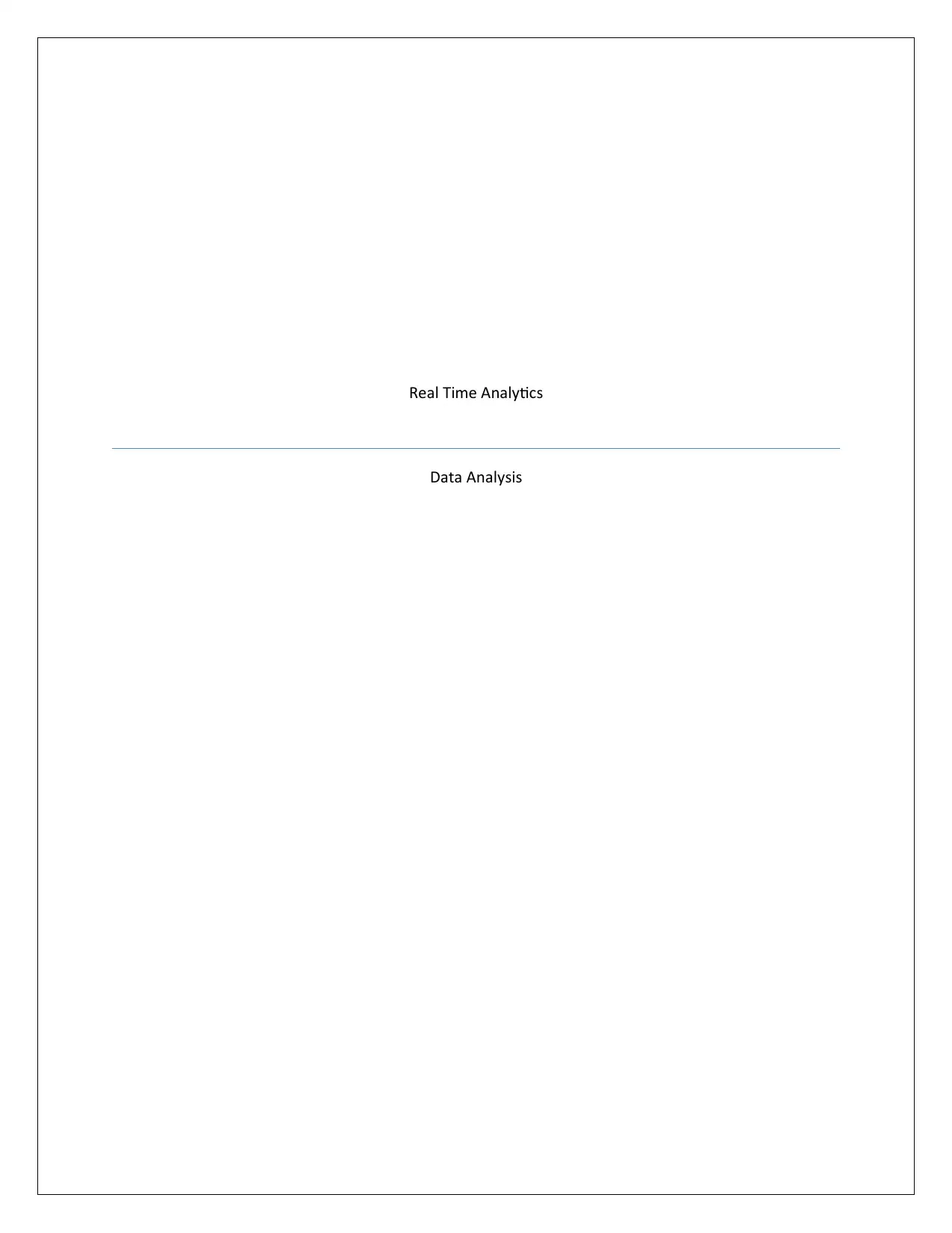
Real Time Analytics
Data Analysis
Data Analysis
Secure Best Marks with AI Grader
Need help grading? Try our AI Grader for instant feedback on your assignments.
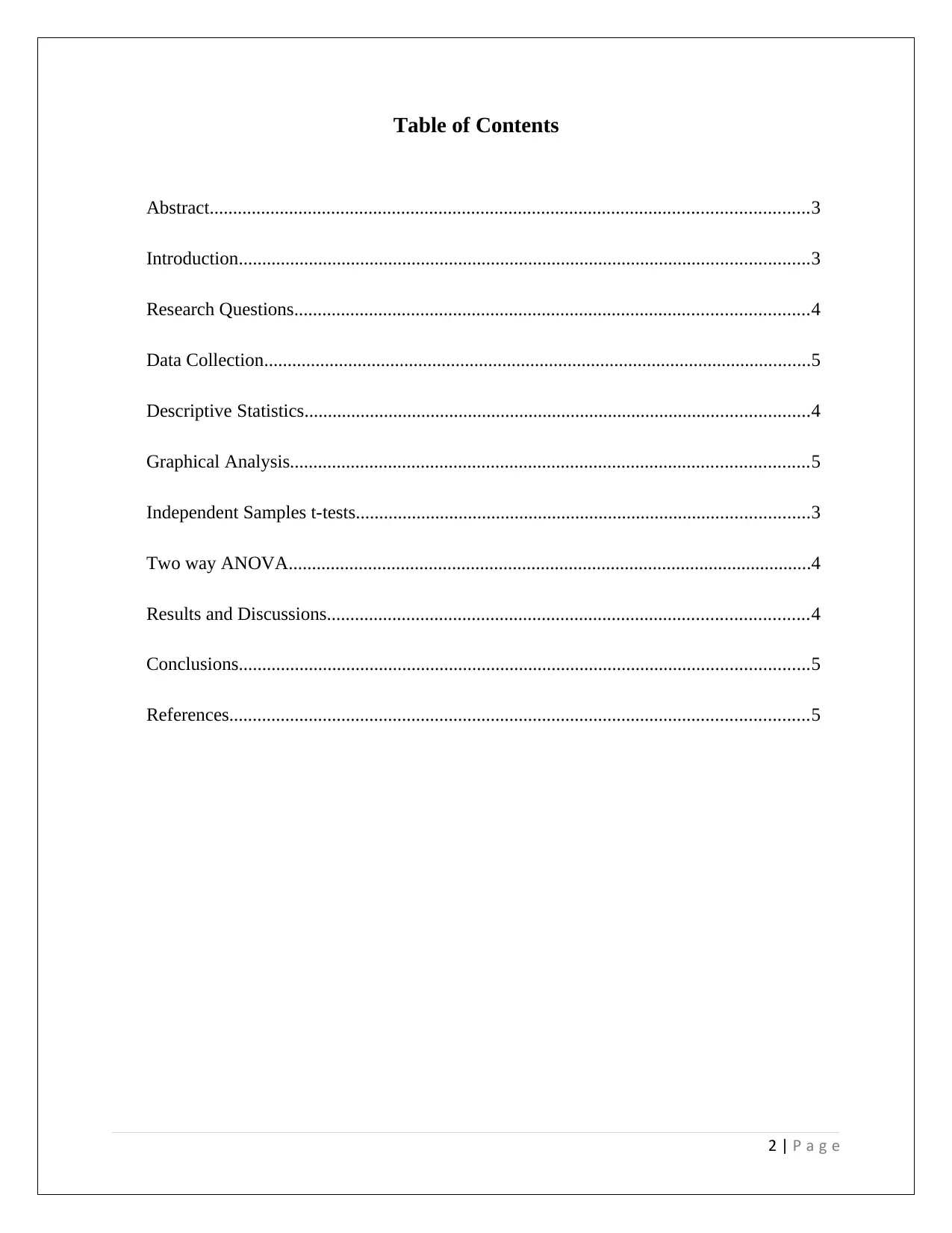
Table of Contents
Abstract................................................................................................................................3
Introduction..........................................................................................................................3
Research Questions..............................................................................................................4
Data Collection.....................................................................................................................5
Descriptive Statistics............................................................................................................4
Graphical Analysis...............................................................................................................5
Independent Samples t-tests.................................................................................................3
Two way ANOVA................................................................................................................4
Results and Discussions.......................................................................................................4
Conclusions..........................................................................................................................5
References............................................................................................................................5
2 | P a g e
Abstract................................................................................................................................3
Introduction..........................................................................................................................3
Research Questions..............................................................................................................4
Data Collection.....................................................................................................................5
Descriptive Statistics............................................................................................................4
Graphical Analysis...............................................................................................................5
Independent Samples t-tests.................................................................................................3
Two way ANOVA................................................................................................................4
Results and Discussions.......................................................................................................4
Conclusions..........................................................................................................................5
References............................................................................................................................5
2 | P a g e
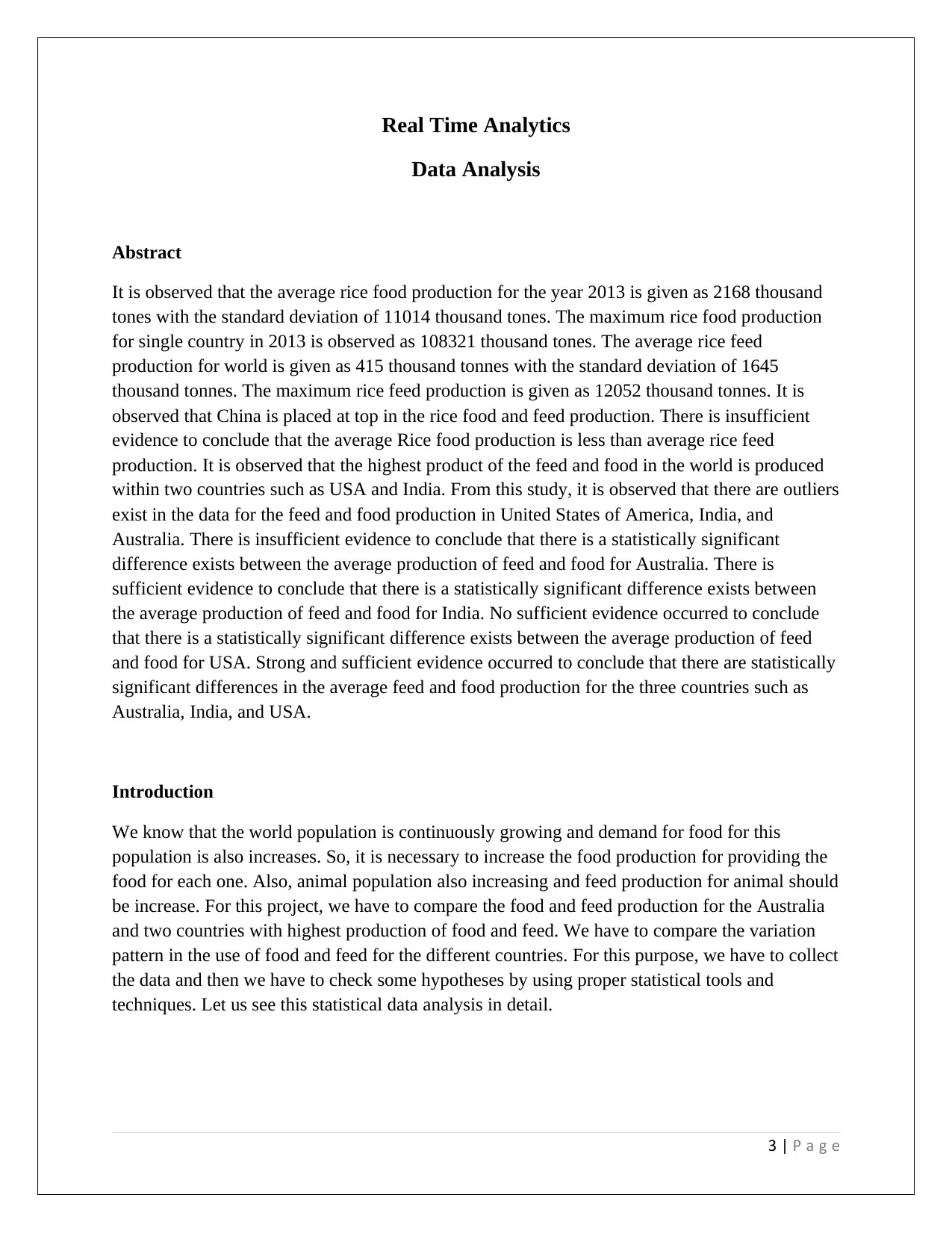
Real Time Analytics
Data Analysis
Abstract
It is observed that the average rice food production for the year 2013 is given as 2168 thousand
tones with the standard deviation of 11014 thousand tones. The maximum rice food production
for single country in 2013 is observed as 108321 thousand tones. The average rice feed
production for world is given as 415 thousand tonnes with the standard deviation of 1645
thousand tonnes. The maximum rice feed production is given as 12052 thousand tonnes. It is
observed that China is placed at top in the rice food and feed production. There is insufficient
evidence to conclude that the average Rice food production is less than average rice feed
production. It is observed that the highest product of the feed and food in the world is produced
within two countries such as USA and India. From this study, it is observed that there are outliers
exist in the data for the feed and food production in United States of America, India, and
Australia. There is insufficient evidence to conclude that there is a statistically significant
difference exists between the average production of feed and food for Australia. There is
sufficient evidence to conclude that there is a statistically significant difference exists between
the average production of feed and food for India. No sufficient evidence occurred to conclude
that there is a statistically significant difference exists between the average production of feed
and food for USA. Strong and sufficient evidence occurred to conclude that there are statistically
significant differences in the average feed and food production for the three countries such as
Australia, India, and USA.
Introduction
We know that the world population is continuously growing and demand for food for this
population is also increases. So, it is necessary to increase the food production for providing the
food for each one. Also, animal population also increasing and feed production for animal should
be increase. For this project, we have to compare the food and feed production for the Australia
and two countries with highest production of food and feed. We have to compare the variation
pattern in the use of food and feed for the different countries. For this purpose, we have to collect
the data and then we have to check some hypotheses by using proper statistical tools and
techniques. Let us see this statistical data analysis in detail.
3 | P a g e
Data Analysis
Abstract
It is observed that the average rice food production for the year 2013 is given as 2168 thousand
tones with the standard deviation of 11014 thousand tones. The maximum rice food production
for single country in 2013 is observed as 108321 thousand tones. The average rice feed
production for world is given as 415 thousand tonnes with the standard deviation of 1645
thousand tonnes. The maximum rice feed production is given as 12052 thousand tonnes. It is
observed that China is placed at top in the rice food and feed production. There is insufficient
evidence to conclude that the average Rice food production is less than average rice feed
production. It is observed that the highest product of the feed and food in the world is produced
within two countries such as USA and India. From this study, it is observed that there are outliers
exist in the data for the feed and food production in United States of America, India, and
Australia. There is insufficient evidence to conclude that there is a statistically significant
difference exists between the average production of feed and food for Australia. There is
sufficient evidence to conclude that there is a statistically significant difference exists between
the average production of feed and food for India. No sufficient evidence occurred to conclude
that there is a statistically significant difference exists between the average production of feed
and food for USA. Strong and sufficient evidence occurred to conclude that there are statistically
significant differences in the average feed and food production for the three countries such as
Australia, India, and USA.
Introduction
We know that the world population is continuously growing and demand for food for this
population is also increases. So, it is necessary to increase the food production for providing the
food for each one. Also, animal population also increasing and feed production for animal should
be increase. For this project, we have to compare the food and feed production for the Australia
and two countries with highest production of food and feed. We have to compare the variation
pattern in the use of food and feed for the different countries. For this purpose, we have to collect
the data and then we have to check some hypotheses by using proper statistical tools and
techniques. Let us see this statistical data analysis in detail.
3 | P a g e
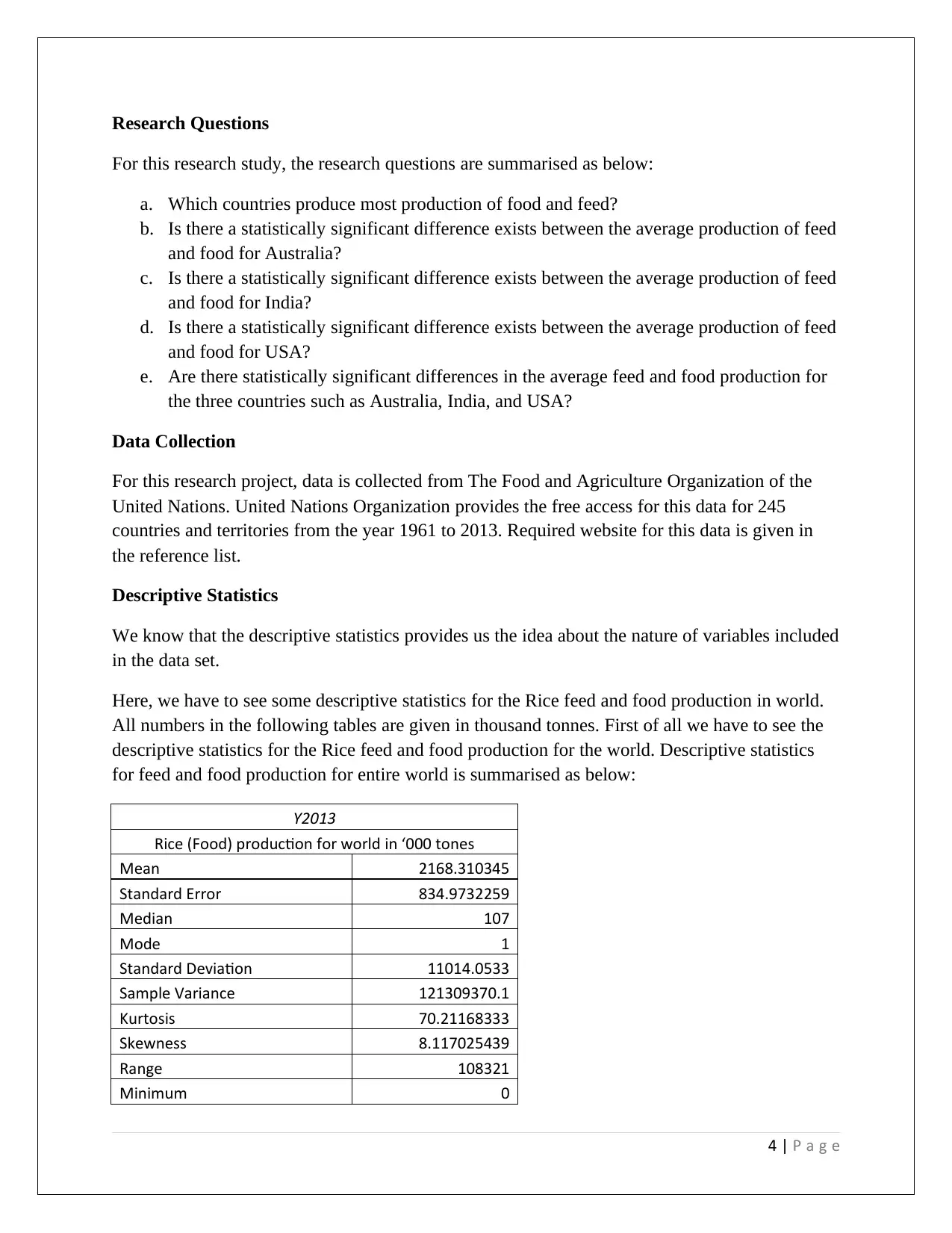
Research Questions
For this research study, the research questions are summarised as below:
a. Which countries produce most production of food and feed?
b. Is there a statistically significant difference exists between the average production of feed
and food for Australia?
c. Is there a statistically significant difference exists between the average production of feed
and food for India?
d. Is there a statistically significant difference exists between the average production of feed
and food for USA?
e. Are there statistically significant differences in the average feed and food production for
the three countries such as Australia, India, and USA?
Data Collection
For this research project, data is collected from The Food and Agriculture Organization of the
United Nations. United Nations Organization provides the free access for this data for 245
countries and territories from the year 1961 to 2013. Required website for this data is given in
the reference list.
Descriptive Statistics
We know that the descriptive statistics provides us the idea about the nature of variables included
in the data set.
Here, we have to see some descriptive statistics for the Rice feed and food production in world.
All numbers in the following tables are given in thousand tonnes. First of all we have to see the
descriptive statistics for the Rice feed and food production for the world. Descriptive statistics
for feed and food production for entire world is summarised as below:
Y2013
Rice (Food) production for world in ‘000 tones
Mean 2168.310345
Standard Error 834.9732259
Median 107
Mode 1
Standard Deviation 11014.0533
Sample Variance 121309370.1
Kurtosis 70.21168333
Skewness 8.117025439
Range 108321
Minimum 0
4 | P a g e
For this research study, the research questions are summarised as below:
a. Which countries produce most production of food and feed?
b. Is there a statistically significant difference exists between the average production of feed
and food for Australia?
c. Is there a statistically significant difference exists between the average production of feed
and food for India?
d. Is there a statistically significant difference exists between the average production of feed
and food for USA?
e. Are there statistically significant differences in the average feed and food production for
the three countries such as Australia, India, and USA?
Data Collection
For this research project, data is collected from The Food and Agriculture Organization of the
United Nations. United Nations Organization provides the free access for this data for 245
countries and territories from the year 1961 to 2013. Required website for this data is given in
the reference list.
Descriptive Statistics
We know that the descriptive statistics provides us the idea about the nature of variables included
in the data set.
Here, we have to see some descriptive statistics for the Rice feed and food production in world.
All numbers in the following tables are given in thousand tonnes. First of all we have to see the
descriptive statistics for the Rice feed and food production for the world. Descriptive statistics
for feed and food production for entire world is summarised as below:
Y2013
Rice (Food) production for world in ‘000 tones
Mean 2168.310345
Standard Error 834.9732259
Median 107
Mode 1
Standard Deviation 11014.0533
Sample Variance 121309370.1
Kurtosis 70.21168333
Skewness 8.117025439
Range 108321
Minimum 0
4 | P a g e
Secure Best Marks with AI Grader
Need help grading? Try our AI Grader for instant feedback on your assignments.
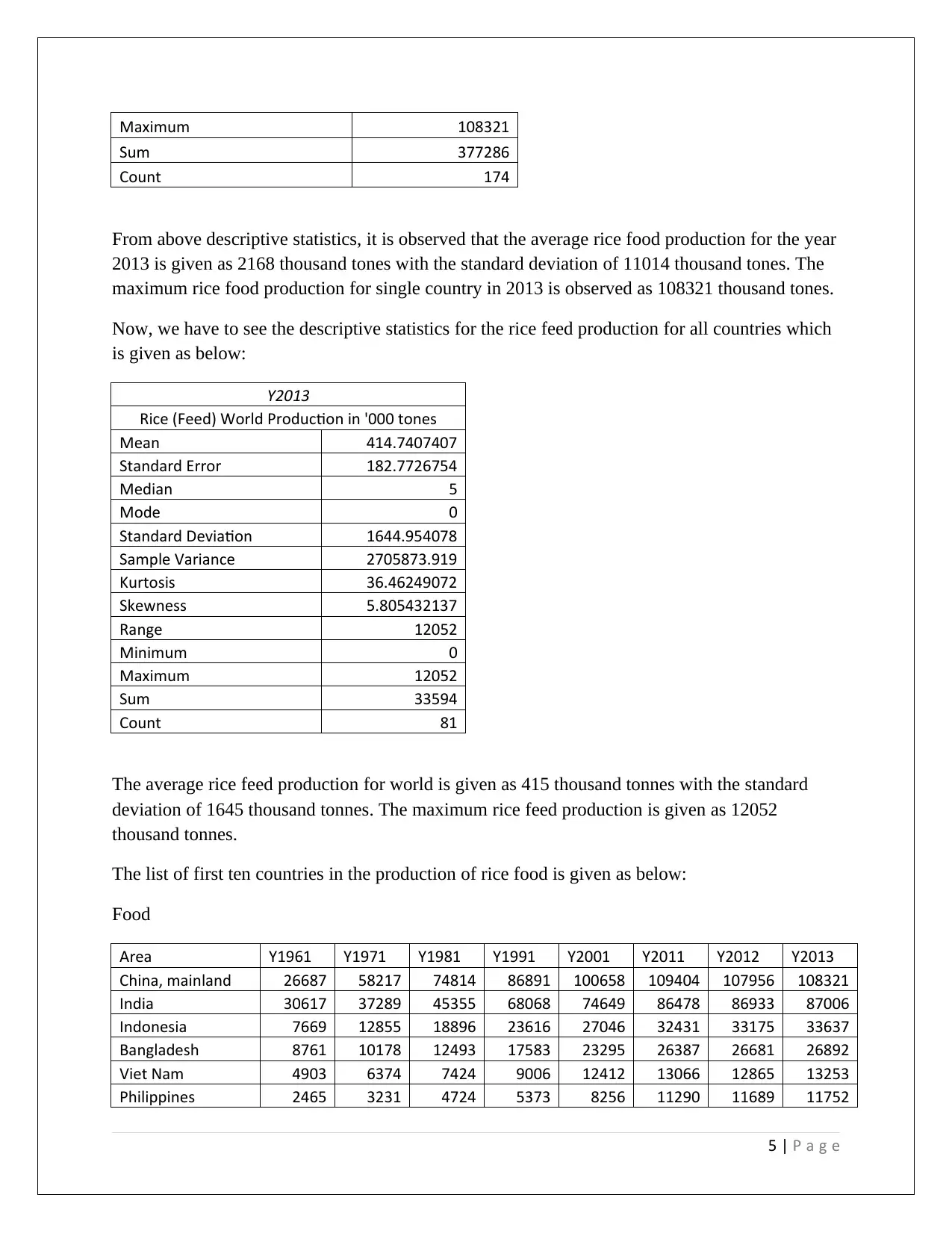
Maximum 108321
Sum 377286
Count 174
From above descriptive statistics, it is observed that the average rice food production for the year
2013 is given as 2168 thousand tones with the standard deviation of 11014 thousand tones. The
maximum rice food production for single country in 2013 is observed as 108321 thousand tones.
Now, we have to see the descriptive statistics for the rice feed production for all countries which
is given as below:
Y2013
Rice (Feed) World Production in '000 tones
Mean 414.7407407
Standard Error 182.7726754
Median 5
Mode 0
Standard Deviation 1644.954078
Sample Variance 2705873.919
Kurtosis 36.46249072
Skewness 5.805432137
Range 12052
Minimum 0
Maximum 12052
Sum 33594
Count 81
The average rice feed production for world is given as 415 thousand tonnes with the standard
deviation of 1645 thousand tonnes. The maximum rice feed production is given as 12052
thousand tonnes.
The list of first ten countries in the production of rice food is given as below:
Food
Area Y1961 Y1971 Y1981 Y1991 Y2001 Y2011 Y2012 Y2013
China, mainland 26687 58217 74814 86891 100658 109404 107956 108321
India 30617 37289 45355 68068 74649 86478 86933 87006
Indonesia 7669 12855 18896 23616 27046 32431 33175 33637
Bangladesh 8761 10178 12493 17583 23295 26387 26681 26892
Viet Nam 4903 6374 7424 9006 12412 13066 12865 13253
Philippines 2465 3231 4724 5373 8256 11290 11689 11752
5 | P a g e
Sum 377286
Count 174
From above descriptive statistics, it is observed that the average rice food production for the year
2013 is given as 2168 thousand tones with the standard deviation of 11014 thousand tones. The
maximum rice food production for single country in 2013 is observed as 108321 thousand tones.
Now, we have to see the descriptive statistics for the rice feed production for all countries which
is given as below:
Y2013
Rice (Feed) World Production in '000 tones
Mean 414.7407407
Standard Error 182.7726754
Median 5
Mode 0
Standard Deviation 1644.954078
Sample Variance 2705873.919
Kurtosis 36.46249072
Skewness 5.805432137
Range 12052
Minimum 0
Maximum 12052
Sum 33594
Count 81
The average rice feed production for world is given as 415 thousand tonnes with the standard
deviation of 1645 thousand tonnes. The maximum rice feed production is given as 12052
thousand tonnes.
The list of first ten countries in the production of rice food is given as below:
Food
Area Y1961 Y1971 Y1981 Y1991 Y2001 Y2011 Y2012 Y2013
China, mainland 26687 58217 74814 86891 100658 109404 107956 108321
India 30617 37289 45355 68068 74649 86478 86933 87006
Indonesia 7669 12855 18896 23616 27046 32431 33175 33637
Bangladesh 8761 10178 12493 17583 23295 26387 26681 26892
Viet Nam 4903 6374 7424 9006 12412 13066 12865 13253
Philippines 2465 3231 4724 5373 8256 11290 11689 11752
5 | P a g e
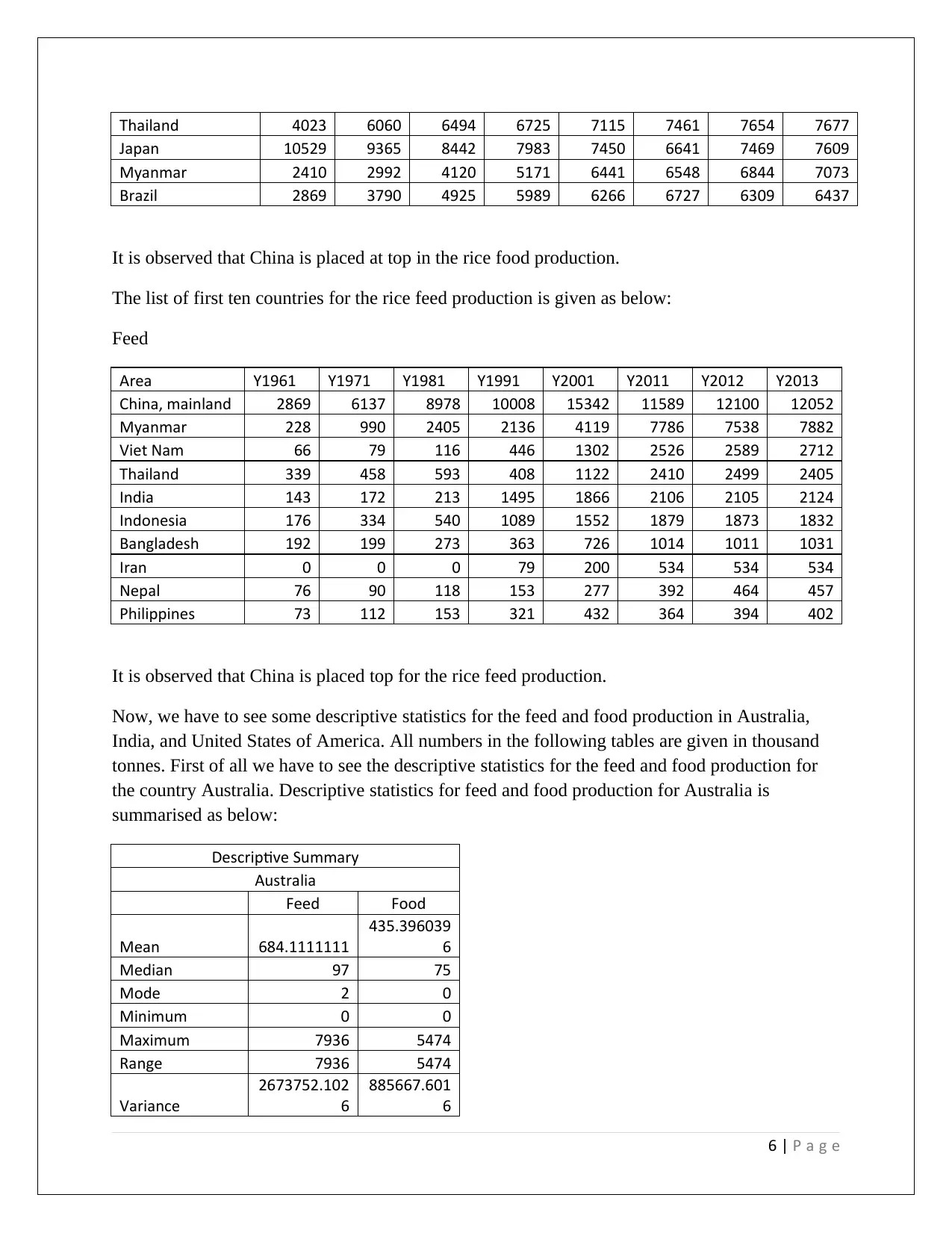
Thailand 4023 6060 6494 6725 7115 7461 7654 7677
Japan 10529 9365 8442 7983 7450 6641 7469 7609
Myanmar 2410 2992 4120 5171 6441 6548 6844 7073
Brazil 2869 3790 4925 5989 6266 6727 6309 6437
It is observed that China is placed at top in the rice food production.
The list of first ten countries for the rice feed production is given as below:
Feed
Area Y1961 Y1971 Y1981 Y1991 Y2001 Y2011 Y2012 Y2013
China, mainland 2869 6137 8978 10008 15342 11589 12100 12052
Myanmar 228 990 2405 2136 4119 7786 7538 7882
Viet Nam 66 79 116 446 1302 2526 2589 2712
Thailand 339 458 593 408 1122 2410 2499 2405
India 143 172 213 1495 1866 2106 2105 2124
Indonesia 176 334 540 1089 1552 1879 1873 1832
Bangladesh 192 199 273 363 726 1014 1011 1031
Iran 0 0 0 79 200 534 534 534
Nepal 76 90 118 153 277 392 464 457
Philippines 73 112 153 321 432 364 394 402
It is observed that China is placed top for the rice feed production.
Now, we have to see some descriptive statistics for the feed and food production in Australia,
India, and United States of America. All numbers in the following tables are given in thousand
tonnes. First of all we have to see the descriptive statistics for the feed and food production for
the country Australia. Descriptive statistics for feed and food production for Australia is
summarised as below:
Descriptive Summary
Australia
Feed Food
Mean 684.1111111
435.396039
6
Median 97 75
Mode 2 0
Minimum 0 0
Maximum 7936 5474
Range 7936 5474
Variance
2673752.102
6
885667.601
6
6 | P a g e
Japan 10529 9365 8442 7983 7450 6641 7469 7609
Myanmar 2410 2992 4120 5171 6441 6548 6844 7073
Brazil 2869 3790 4925 5989 6266 6727 6309 6437
It is observed that China is placed at top in the rice food production.
The list of first ten countries for the rice feed production is given as below:
Feed
Area Y1961 Y1971 Y1981 Y1991 Y2001 Y2011 Y2012 Y2013
China, mainland 2869 6137 8978 10008 15342 11589 12100 12052
Myanmar 228 990 2405 2136 4119 7786 7538 7882
Viet Nam 66 79 116 446 1302 2526 2589 2712
Thailand 339 458 593 408 1122 2410 2499 2405
India 143 172 213 1495 1866 2106 2105 2124
Indonesia 176 334 540 1089 1552 1879 1873 1832
Bangladesh 192 199 273 363 726 1014 1011 1031
Iran 0 0 0 79 200 534 534 534
Nepal 76 90 118 153 277 392 464 457
Philippines 73 112 153 321 432 364 394 402
It is observed that China is placed top for the rice feed production.
Now, we have to see some descriptive statistics for the feed and food production in Australia,
India, and United States of America. All numbers in the following tables are given in thousand
tonnes. First of all we have to see the descriptive statistics for the feed and food production for
the country Australia. Descriptive statistics for feed and food production for Australia is
summarised as below:
Descriptive Summary
Australia
Feed Food
Mean 684.1111111
435.396039
6
Median 97 75
Mode 2 0
Minimum 0 0
Maximum 7936 5474
Range 7936 5474
Variance
2673752.102
6
885667.601
6
6 | P a g e
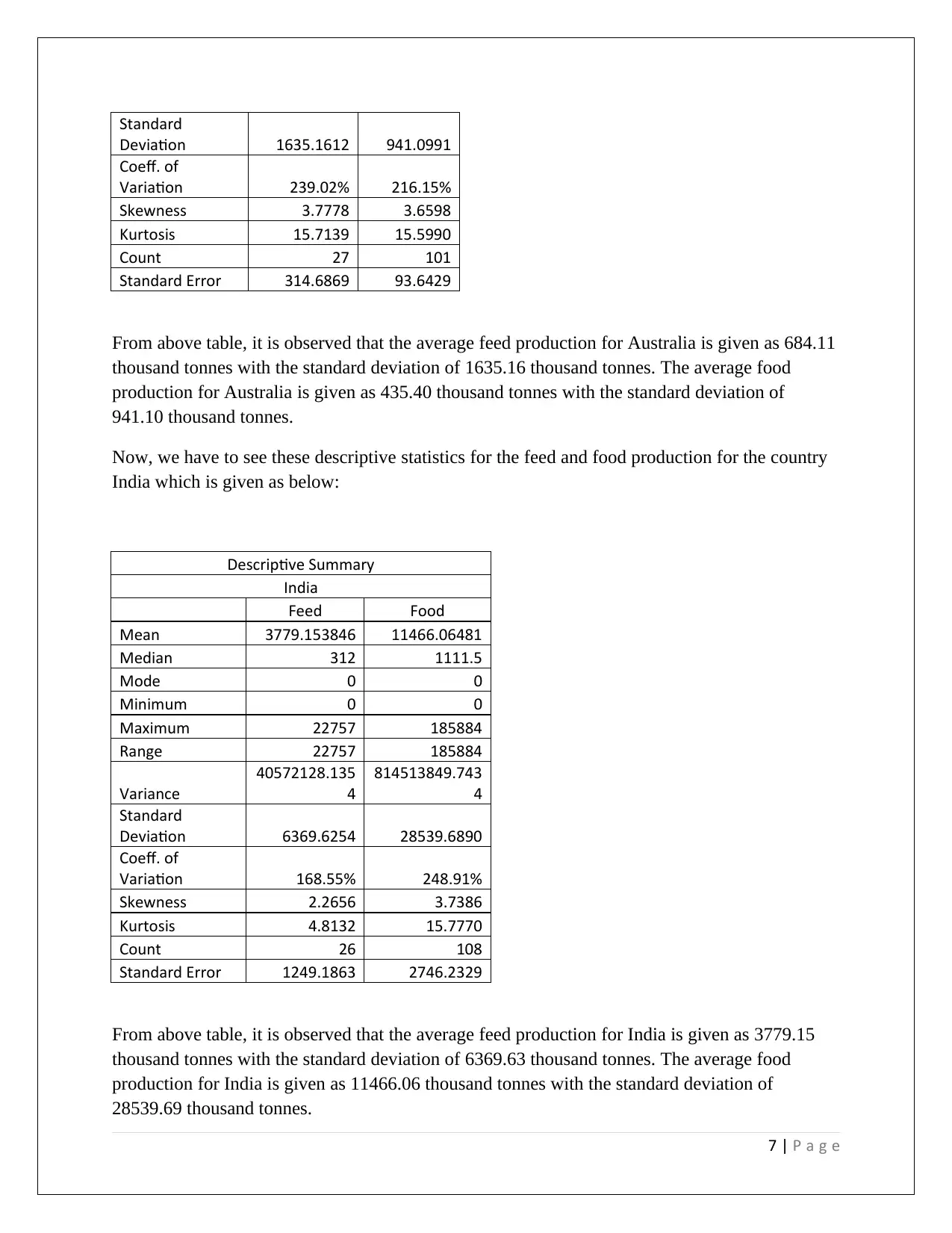
Standard
Deviation 1635.1612 941.0991
Coeff. of
Variation 239.02% 216.15%
Skewness 3.7778 3.6598
Kurtosis 15.7139 15.5990
Count 27 101
Standard Error 314.6869 93.6429
From above table, it is observed that the average feed production for Australia is given as 684.11
thousand tonnes with the standard deviation of 1635.16 thousand tonnes. The average food
production for Australia is given as 435.40 thousand tonnes with the standard deviation of
941.10 thousand tonnes.
Now, we have to see these descriptive statistics for the feed and food production for the country
India which is given as below:
Descriptive Summary
India
Feed Food
Mean 3779.153846 11466.06481
Median 312 1111.5
Mode 0 0
Minimum 0 0
Maximum 22757 185884
Range 22757 185884
Variance
40572128.135
4
814513849.743
4
Standard
Deviation 6369.6254 28539.6890
Coeff. of
Variation 168.55% 248.91%
Skewness 2.2656 3.7386
Kurtosis 4.8132 15.7770
Count 26 108
Standard Error 1249.1863 2746.2329
From above table, it is observed that the average feed production for India is given as 3779.15
thousand tonnes with the standard deviation of 6369.63 thousand tonnes. The average food
production for India is given as 11466.06 thousand tonnes with the standard deviation of
28539.69 thousand tonnes.
7 | P a g e
Deviation 1635.1612 941.0991
Coeff. of
Variation 239.02% 216.15%
Skewness 3.7778 3.6598
Kurtosis 15.7139 15.5990
Count 27 101
Standard Error 314.6869 93.6429
From above table, it is observed that the average feed production for Australia is given as 684.11
thousand tonnes with the standard deviation of 1635.16 thousand tonnes. The average food
production for Australia is given as 435.40 thousand tonnes with the standard deviation of
941.10 thousand tonnes.
Now, we have to see these descriptive statistics for the feed and food production for the country
India which is given as below:
Descriptive Summary
India
Feed Food
Mean 3779.153846 11466.06481
Median 312 1111.5
Mode 0 0
Minimum 0 0
Maximum 22757 185884
Range 22757 185884
Variance
40572128.135
4
814513849.743
4
Standard
Deviation 6369.6254 28539.6890
Coeff. of
Variation 168.55% 248.91%
Skewness 2.2656 3.7386
Kurtosis 4.8132 15.7770
Count 26 108
Standard Error 1249.1863 2746.2329
From above table, it is observed that the average feed production for India is given as 3779.15
thousand tonnes with the standard deviation of 6369.63 thousand tonnes. The average food
production for India is given as 11466.06 thousand tonnes with the standard deviation of
28539.69 thousand tonnes.
7 | P a g e
Paraphrase This Document
Need a fresh take? Get an instant paraphrase of this document with our AI Paraphraser
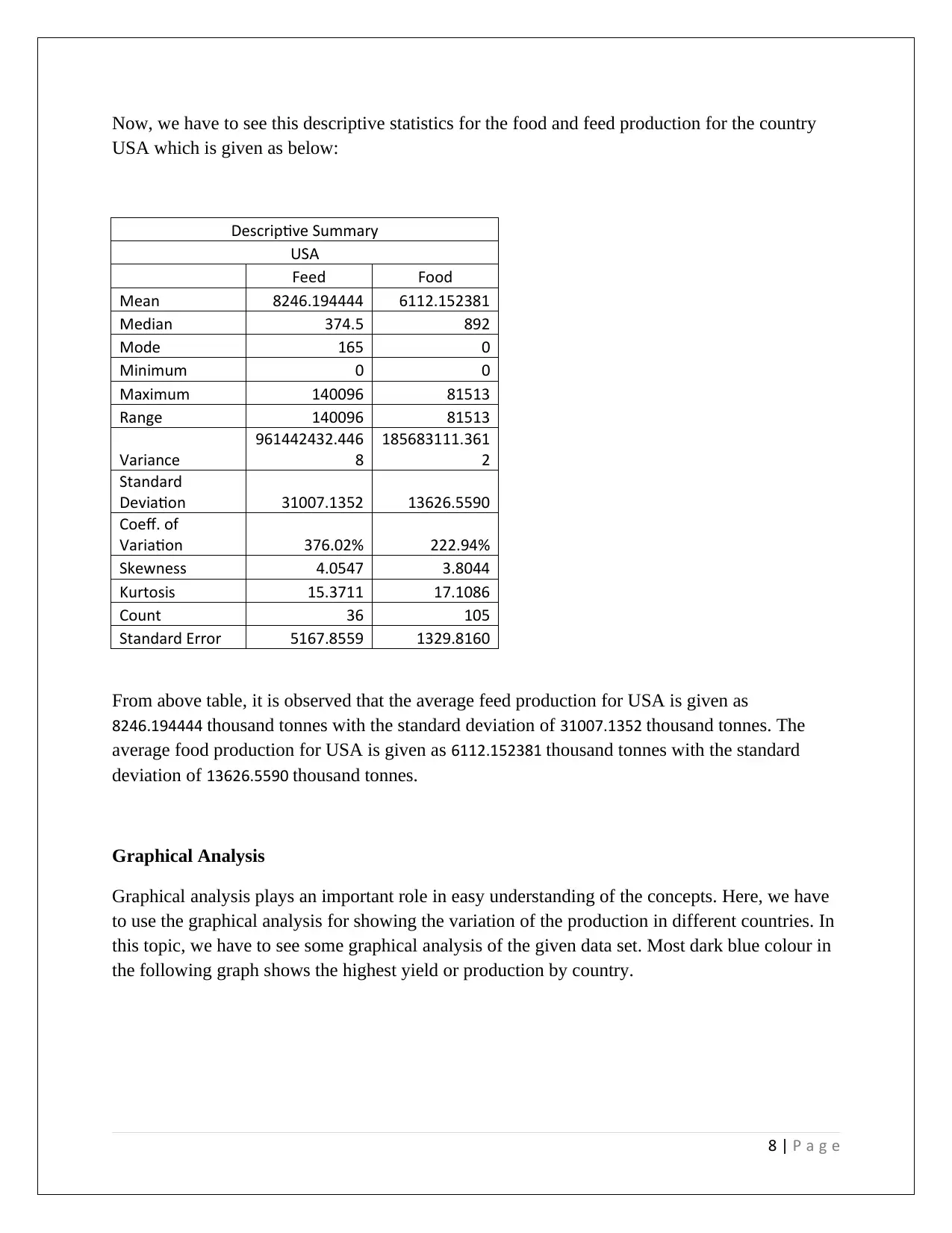
Now, we have to see this descriptive statistics for the food and feed production for the country
USA which is given as below:
Descriptive Summary
USA
Feed Food
Mean 8246.194444 6112.152381
Median 374.5 892
Mode 165 0
Minimum 0 0
Maximum 140096 81513
Range 140096 81513
Variance
961442432.446
8
185683111.361
2
Standard
Deviation 31007.1352 13626.5590
Coeff. of
Variation 376.02% 222.94%
Skewness 4.0547 3.8044
Kurtosis 15.3711 17.1086
Count 36 105
Standard Error 5167.8559 1329.8160
From above table, it is observed that the average feed production for USA is given as
8246.194444 thousand tonnes with the standard deviation of 31007.1352 thousand tonnes. The
average food production for USA is given as 6112.152381 thousand tonnes with the standard
deviation of 13626.5590 thousand tonnes.
Graphical Analysis
Graphical analysis plays an important role in easy understanding of the concepts. Here, we have
to use the graphical analysis for showing the variation of the production in different countries. In
this topic, we have to see some graphical analysis of the given data set. Most dark blue colour in
the following graph shows the highest yield or production by country.
8 | P a g e
USA which is given as below:
Descriptive Summary
USA
Feed Food
Mean 8246.194444 6112.152381
Median 374.5 892
Mode 165 0
Minimum 0 0
Maximum 140096 81513
Range 140096 81513
Variance
961442432.446
8
185683111.361
2
Standard
Deviation 31007.1352 13626.5590
Coeff. of
Variation 376.02% 222.94%
Skewness 4.0547 3.8044
Kurtosis 15.3711 17.1086
Count 36 105
Standard Error 5167.8559 1329.8160
From above table, it is observed that the average feed production for USA is given as
8246.194444 thousand tonnes with the standard deviation of 31007.1352 thousand tonnes. The
average food production for USA is given as 6112.152381 thousand tonnes with the standard
deviation of 13626.5590 thousand tonnes.
Graphical Analysis
Graphical analysis plays an important role in easy understanding of the concepts. Here, we have
to use the graphical analysis for showing the variation of the production in different countries. In
this topic, we have to see some graphical analysis of the given data set. Most dark blue colour in
the following graph shows the highest yield or production by country.
8 | P a g e
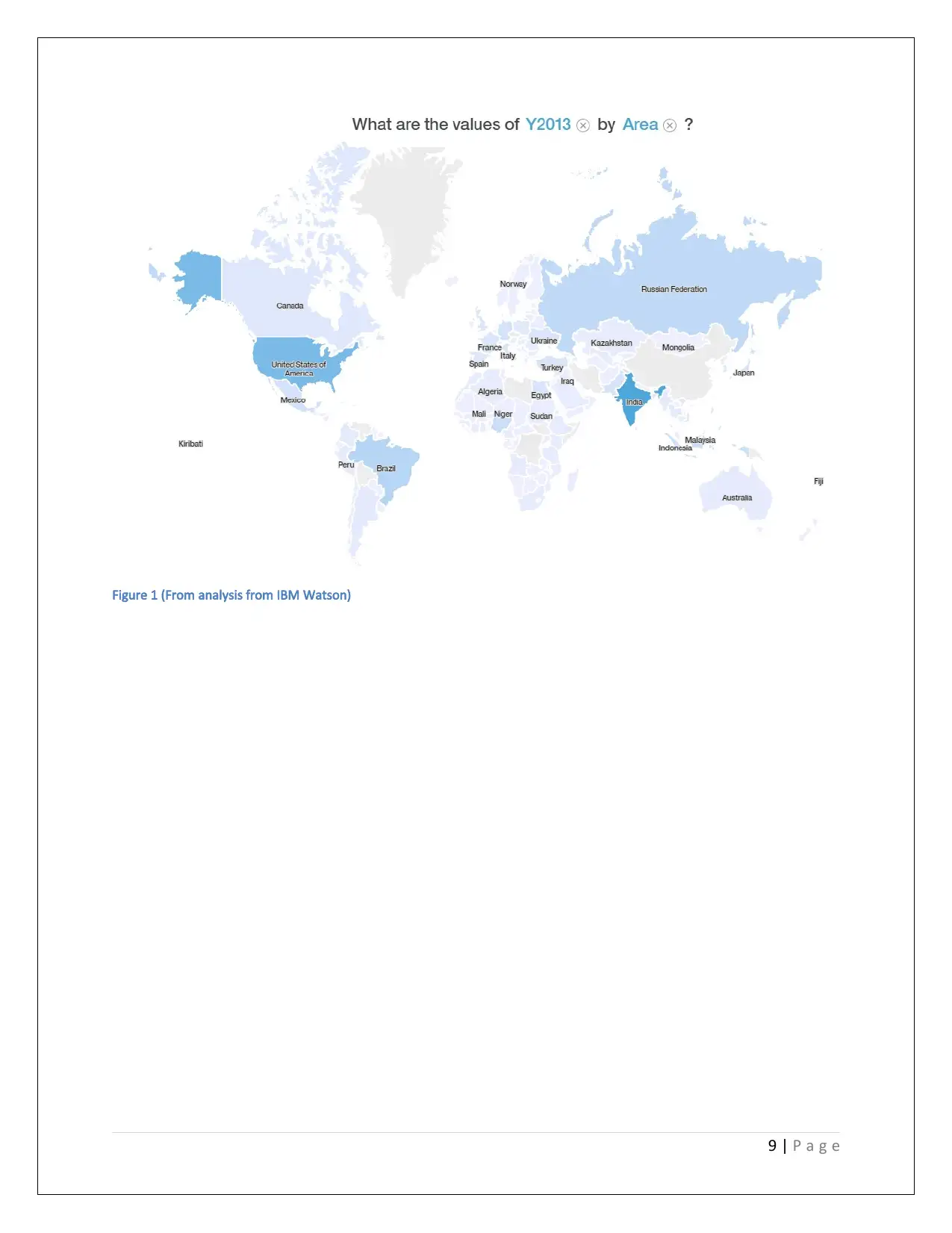
Figure 1 (From analysis from IBM Watson)
9 | P a g e
9 | P a g e
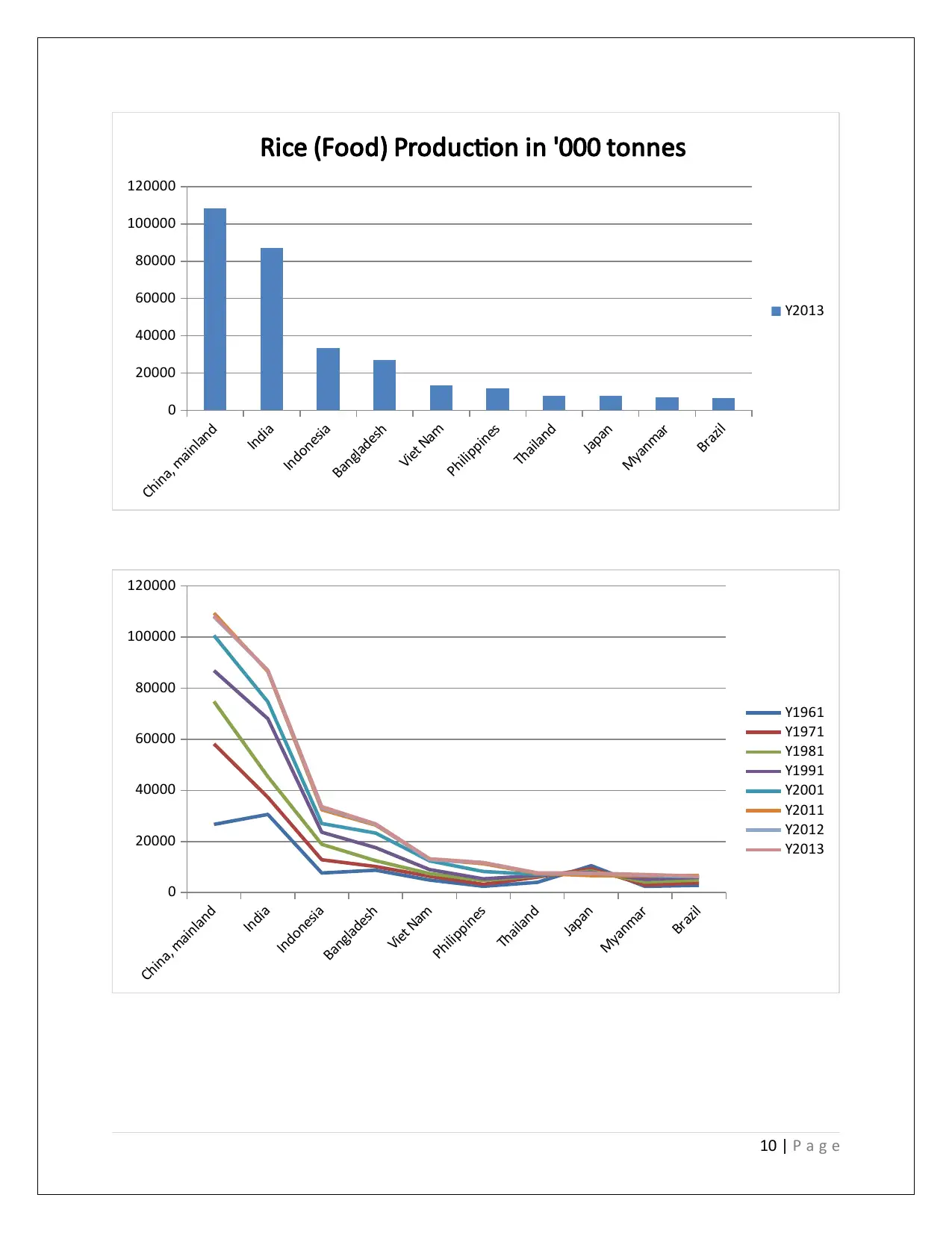
China, mainland
India
Indonesia
Bangladesh
Viet Nam
Philippines
Thailand
Japan
Myanmar
Brazil
0
20000
40000
60000
80000
100000
120000
Rice (Food) Production in '000 tonnes
Y2013
China, mainland
India
Indonesia
Bangladesh
Viet Nam
Philippines
Thailand
Japan
Myanmar
Brazil
0
20000
40000
60000
80000
100000
120000
Y1961
Y1971
Y1981
Y1991
Y2001
Y2011
Y2012
Y2013
10 | P a g e
India
Indonesia
Bangladesh
Viet Nam
Philippines
Thailand
Japan
Myanmar
Brazil
0
20000
40000
60000
80000
100000
120000
Rice (Food) Production in '000 tonnes
Y2013
China, mainland
India
Indonesia
Bangladesh
Viet Nam
Philippines
Thailand
Japan
Myanmar
Brazil
0
20000
40000
60000
80000
100000
120000
Y1961
Y1971
Y1981
Y1991
Y2001
Y2011
Y2012
Y2013
10 | P a g e
Secure Best Marks with AI Grader
Need help grading? Try our AI Grader for instant feedback on your assignments.
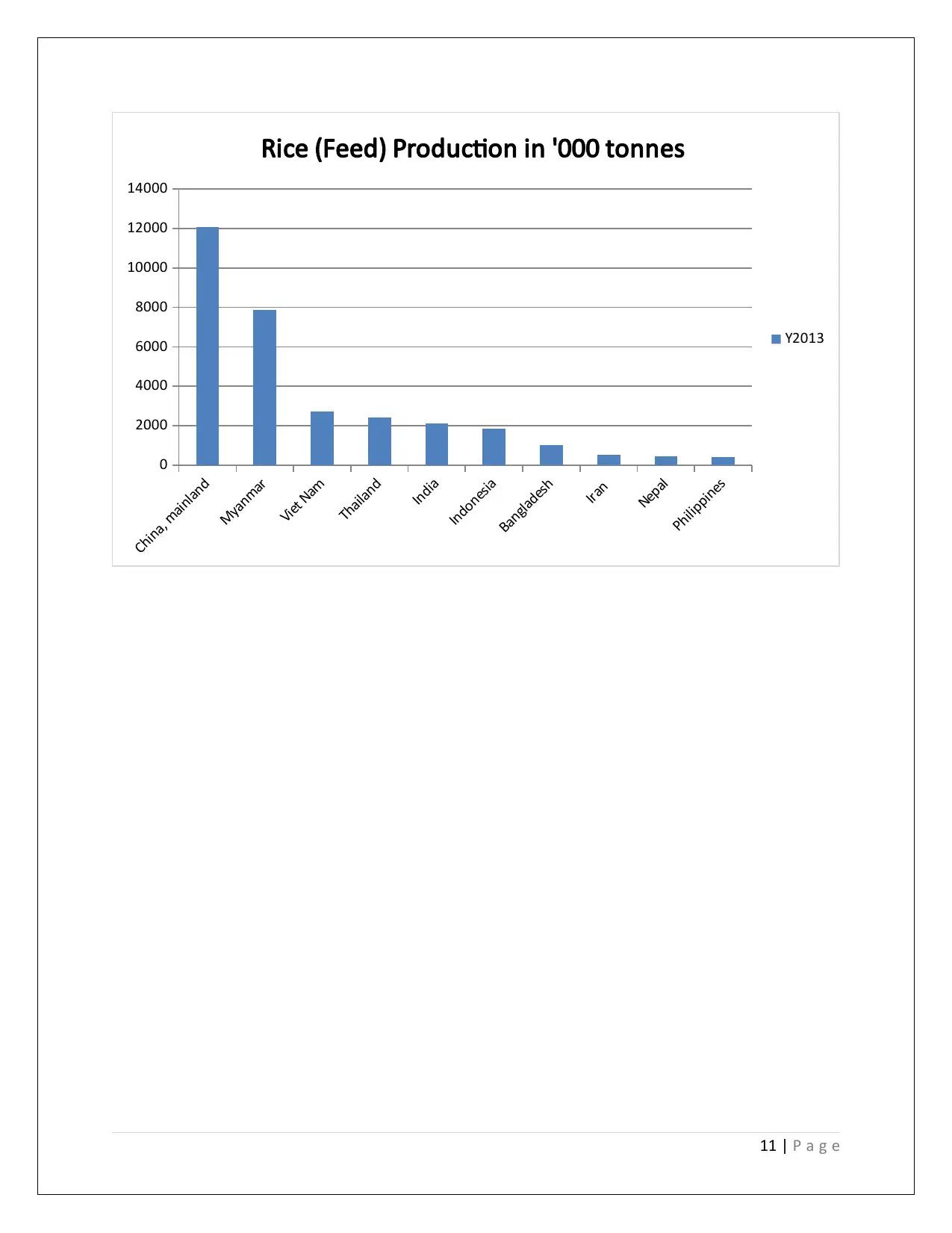
China, mainland
Myanmar
Viet Nam
Thailand
India
Indonesia
Bangladesh
Iran
Nepal
Philippines
0
2000
4000
6000
8000
10000
12000
14000
Rice (Feed) Production in '000 tonnes
Y2013
11 | P a g e
Myanmar
Viet Nam
Thailand
India
Indonesia
Bangladesh
Iran
Nepal
Philippines
0
2000
4000
6000
8000
10000
12000
14000
Rice (Feed) Production in '000 tonnes
Y2013
11 | P a g e
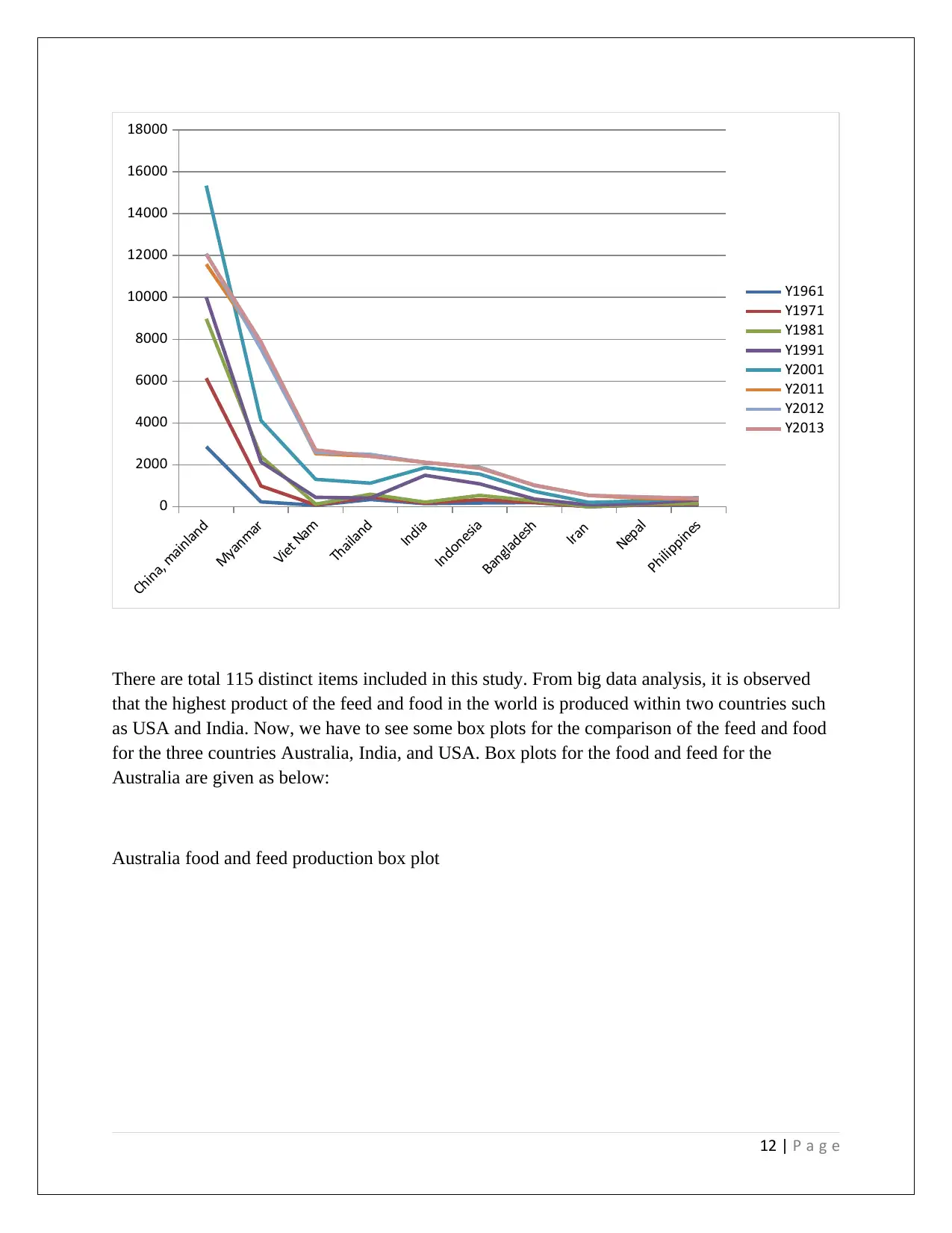
China, mainland
Myanmar
Viet Nam
Thailand
India
Indonesia
Bangladesh
Iran
Nepal
Philippines
0
2000
4000
6000
8000
10000
12000
14000
16000
18000
Y1961
Y1971
Y1981
Y1991
Y2001
Y2011
Y2012
Y2013
There are total 115 distinct items included in this study. From big data analysis, it is observed
that the highest product of the feed and food in the world is produced within two countries such
as USA and India. Now, we have to see some box plots for the comparison of the feed and food
for the three countries Australia, India, and USA. Box plots for the food and feed for the
Australia are given as below:
Australia food and feed production box plot
12 | P a g e
Myanmar
Viet Nam
Thailand
India
Indonesia
Bangladesh
Iran
Nepal
Philippines
0
2000
4000
6000
8000
10000
12000
14000
16000
18000
Y1961
Y1971
Y1981
Y1991
Y2001
Y2011
Y2012
Y2013
There are total 115 distinct items included in this study. From big data analysis, it is observed
that the highest product of the feed and food in the world is produced within two countries such
as USA and India. Now, we have to see some box plots for the comparison of the feed and food
for the three countries Australia, India, and USA. Box plots for the food and feed for the
Australia are given as below:
Australia food and feed production box plot
12 | P a g e
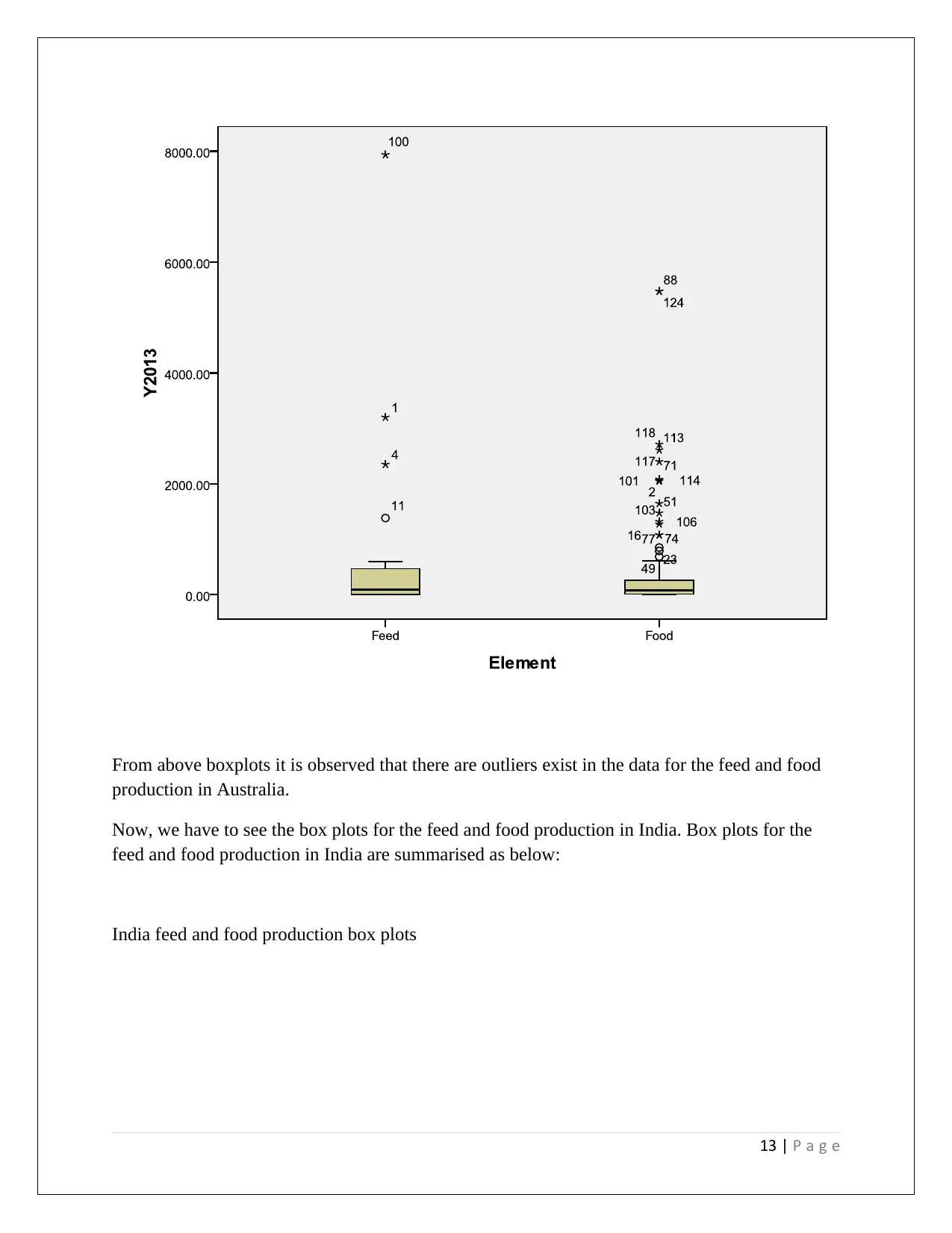
From above boxplots it is observed that there are outliers exist in the data for the feed and food
production in Australia.
Now, we have to see the box plots for the feed and food production in India. Box plots for the
feed and food production in India are summarised as below:
India feed and food production box plots
13 | P a g e
production in Australia.
Now, we have to see the box plots for the feed and food production in India. Box plots for the
feed and food production in India are summarised as below:
India feed and food production box plots
13 | P a g e
Paraphrase This Document
Need a fresh take? Get an instant paraphrase of this document with our AI Paraphraser
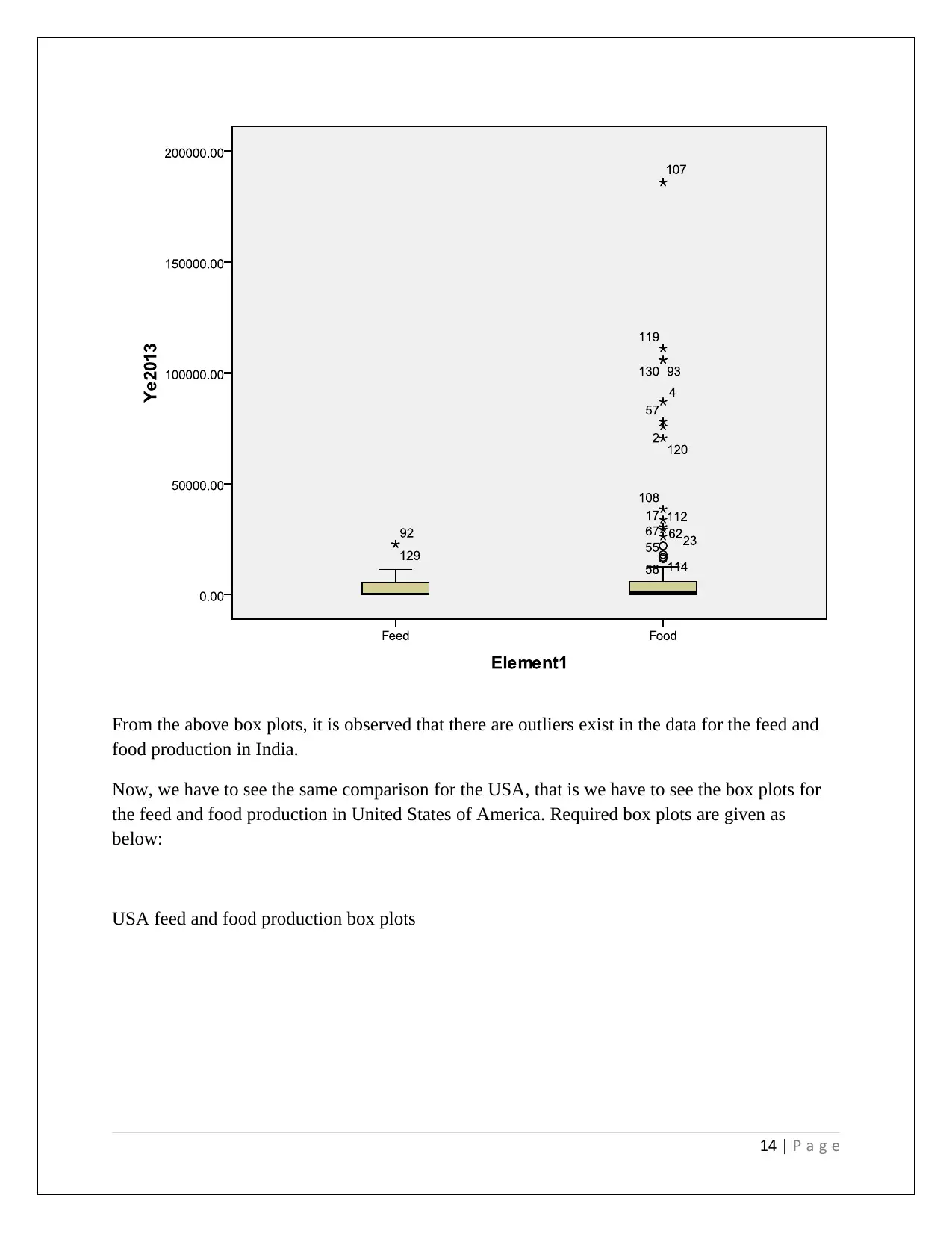
From the above box plots, it is observed that there are outliers exist in the data for the feed and
food production in India.
Now, we have to see the same comparison for the USA, that is we have to see the box plots for
the feed and food production in United States of America. Required box plots are given as
below:
USA feed and food production box plots
14 | P a g e
food production in India.
Now, we have to see the same comparison for the USA, that is we have to see the box plots for
the feed and food production in United States of America. Required box plots are given as
below:
USA feed and food production box plots
14 | P a g e
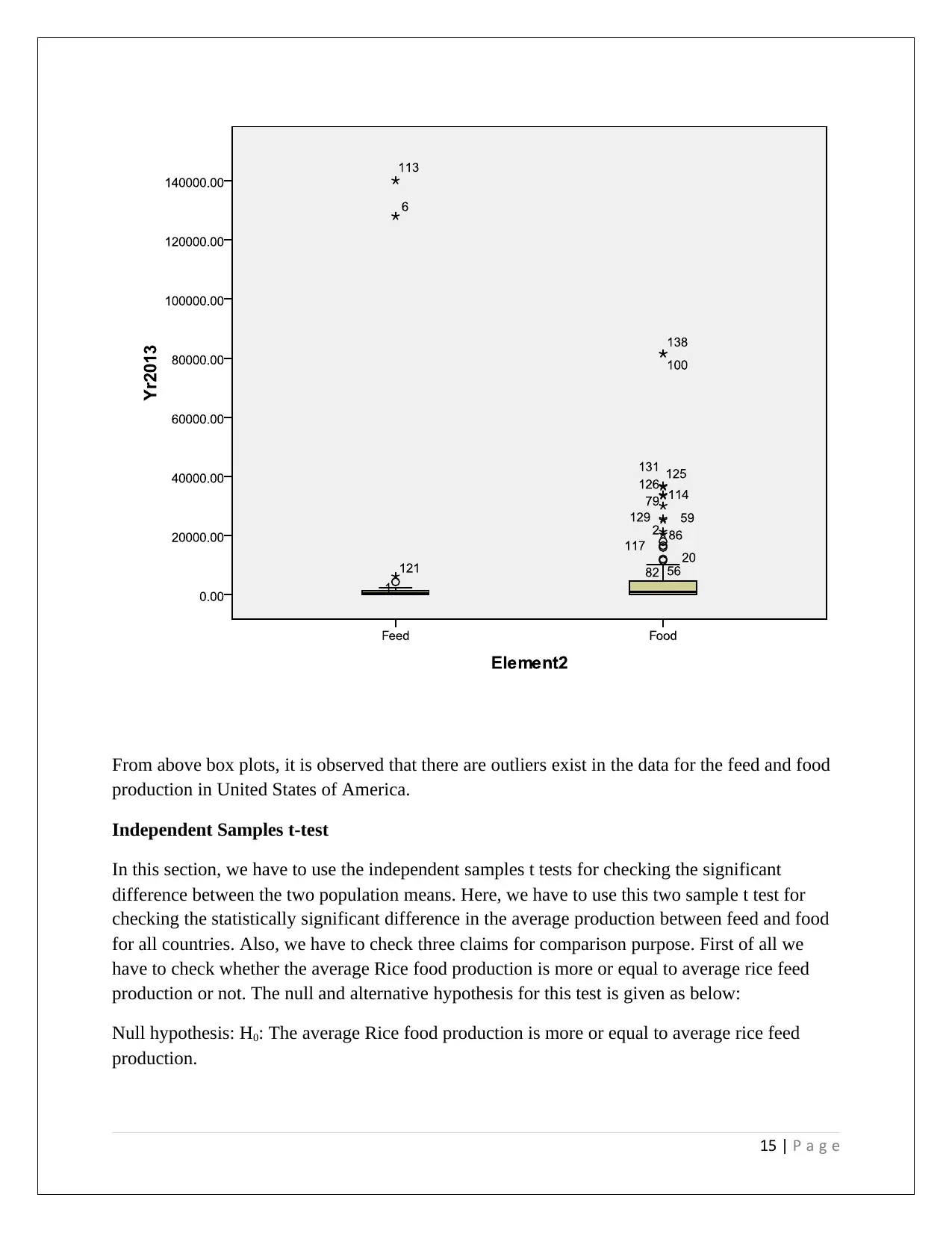
From above box plots, it is observed that there are outliers exist in the data for the feed and food
production in United States of America.
Independent Samples t-test
In this section, we have to use the independent samples t tests for checking the significant
difference between the two population means. Here, we have to use this two sample t test for
checking the statistically significant difference in the average production between feed and food
for all countries. Also, we have to check three claims for comparison purpose. First of all we
have to check whether the average Rice food production is more or equal to average rice feed
production or not. The null and alternative hypothesis for this test is given as below:
Null hypothesis: H0: The average Rice food production is more or equal to average rice feed
production.
15 | P a g e
production in United States of America.
Independent Samples t-test
In this section, we have to use the independent samples t tests for checking the significant
difference between the two population means. Here, we have to use this two sample t test for
checking the statistically significant difference in the average production between feed and food
for all countries. Also, we have to check three claims for comparison purpose. First of all we
have to check whether the average Rice food production is more or equal to average rice feed
production or not. The null and alternative hypothesis for this test is given as below:
Null hypothesis: H0: The average Rice food production is more or equal to average rice feed
production.
15 | P a g e
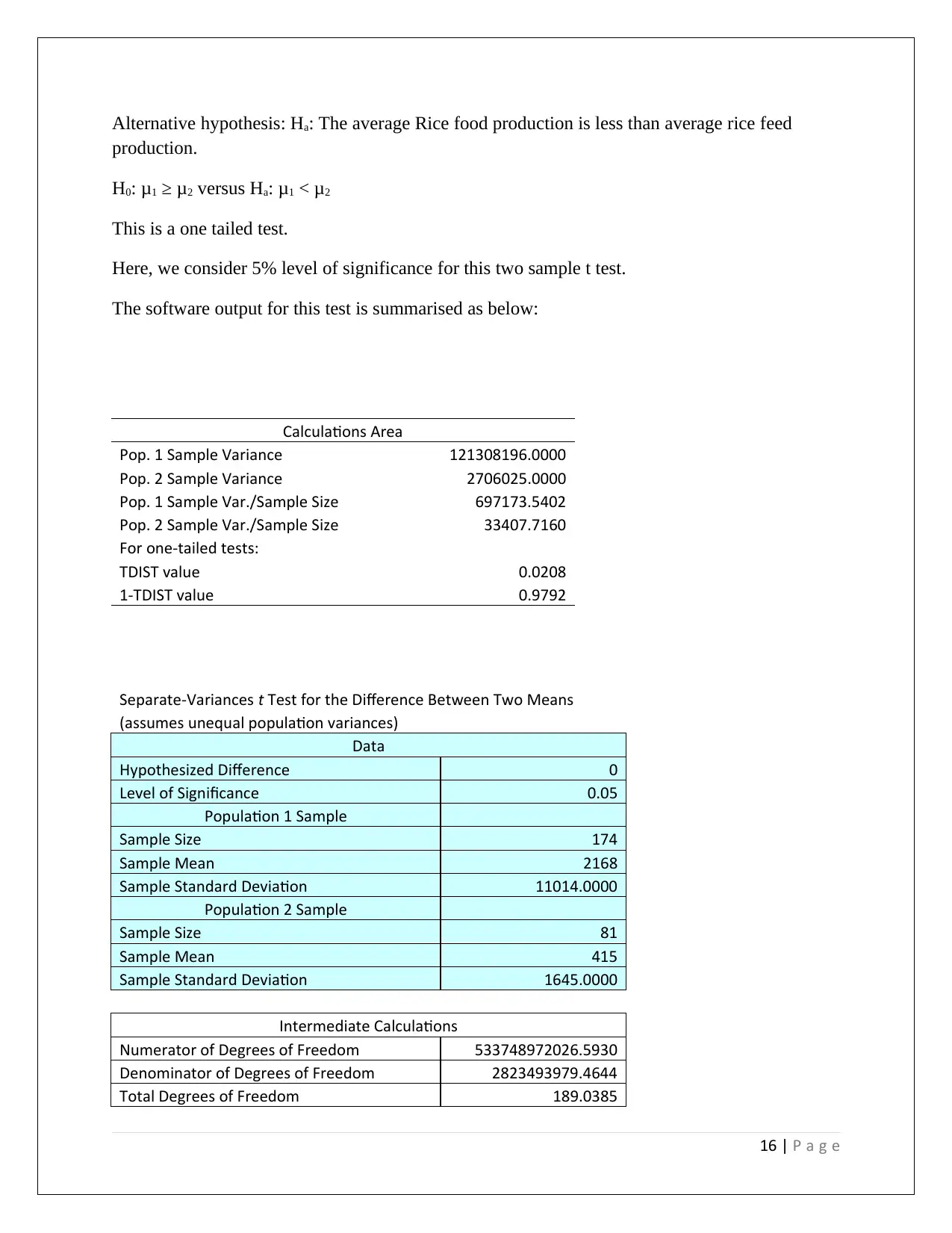
Alternative hypothesis: Ha: The average Rice food production is less than average rice feed
production.
H0: μ1 ≥ μ2 versus Ha: μ1 < μ2
This is a one tailed test.
Here, we consider 5% level of significance for this two sample t test.
The software output for this test is summarised as below:
Calculations Area
Pop. 1 Sample Variance 121308196.0000
Pop. 2 Sample Variance 2706025.0000
Pop. 1 Sample Var./Sample Size 697173.5402
Pop. 2 Sample Var./Sample Size 33407.7160
For one-tailed tests:
TDIST value 0.0208
1-TDIST value 0.9792
Separate-Variances t Test for the Difference Between Two Means
(assumes unequal population variances)
Data
Hypothesized Difference 0
Level of Significance 0.05
Population 1 Sample
Sample Size 174
Sample Mean 2168
Sample Standard Deviation 11014.0000
Population 2 Sample
Sample Size 81
Sample Mean 415
Sample Standard Deviation 1645.0000
Intermediate Calculations
Numerator of Degrees of Freedom 533748972026.5930
Denominator of Degrees of Freedom 2823493979.4644
Total Degrees of Freedom 189.0385
16 | P a g e
production.
H0: μ1 ≥ μ2 versus Ha: μ1 < μ2
This is a one tailed test.
Here, we consider 5% level of significance for this two sample t test.
The software output for this test is summarised as below:
Calculations Area
Pop. 1 Sample Variance 121308196.0000
Pop. 2 Sample Variance 2706025.0000
Pop. 1 Sample Var./Sample Size 697173.5402
Pop. 2 Sample Var./Sample Size 33407.7160
For one-tailed tests:
TDIST value 0.0208
1-TDIST value 0.9792
Separate-Variances t Test for the Difference Between Two Means
(assumes unequal population variances)
Data
Hypothesized Difference 0
Level of Significance 0.05
Population 1 Sample
Sample Size 174
Sample Mean 2168
Sample Standard Deviation 11014.0000
Population 2 Sample
Sample Size 81
Sample Mean 415
Sample Standard Deviation 1645.0000
Intermediate Calculations
Numerator of Degrees of Freedom 533748972026.5930
Denominator of Degrees of Freedom 2823493979.4644
Total Degrees of Freedom 189.0385
16 | P a g e
Secure Best Marks with AI Grader
Need help grading? Try our AI Grader for instant feedback on your assignments.
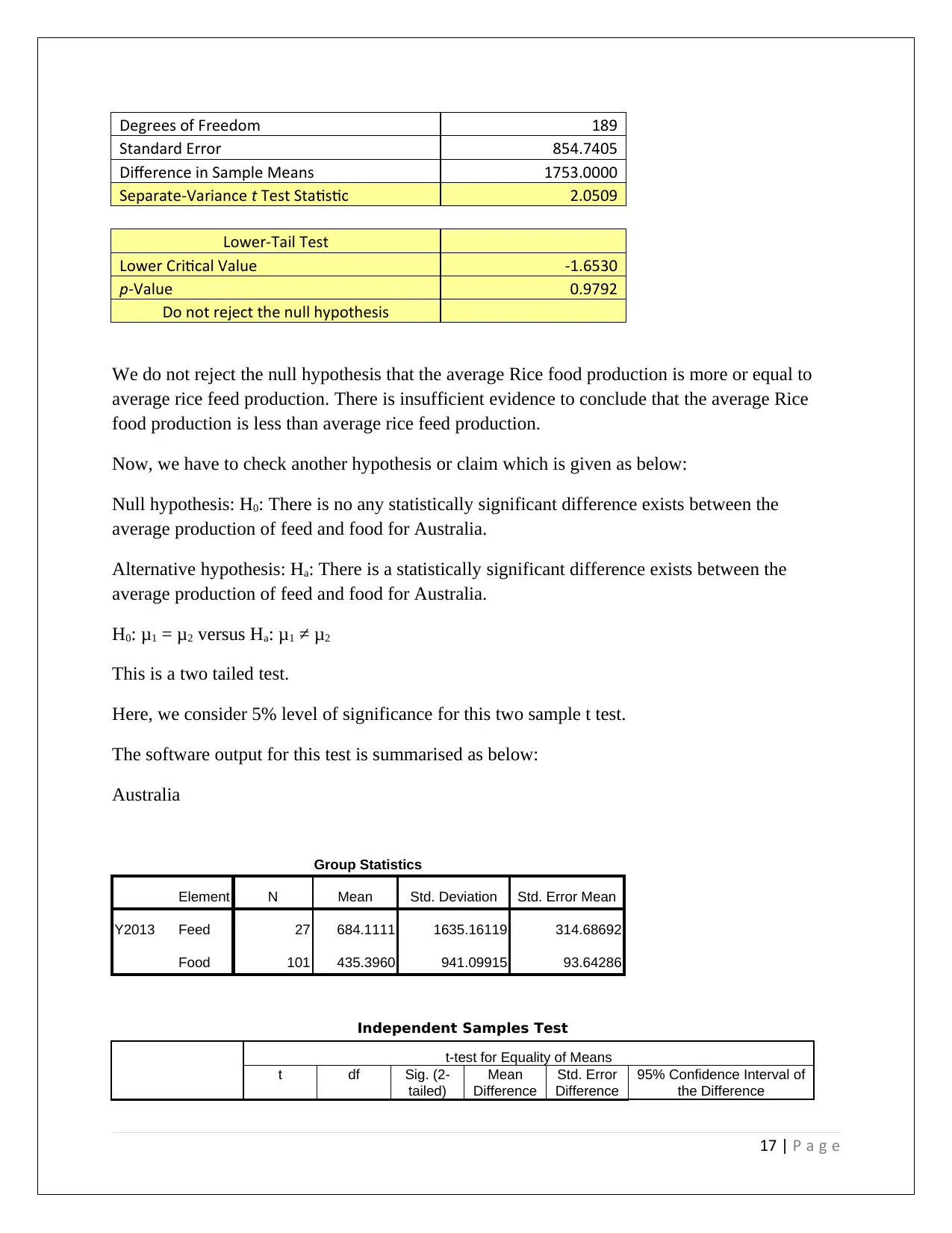
Degrees of Freedom 189
Standard Error 854.7405
Difference in Sample Means 1753.0000
Separate-Variance t Test Statistic 2.0509
Lower-Tail Test
Lower Critical Value -1.6530
p-Value 0.9792
Do not reject the null hypothesis
We do not reject the null hypothesis that the average Rice food production is more or equal to
average rice feed production. There is insufficient evidence to conclude that the average Rice
food production is less than average rice feed production.
Now, we have to check another hypothesis or claim which is given as below:
Null hypothesis: H0: There is no any statistically significant difference exists between the
average production of feed and food for Australia.
Alternative hypothesis: Ha: There is a statistically significant difference exists between the
average production of feed and food for Australia.
H0: μ1 = μ2 versus Ha: μ1 ≠ μ2
This is a two tailed test.
Here, we consider 5% level of significance for this two sample t test.
The software output for this test is summarised as below:
Australia
Group Statistics
Element N Mean Std. Deviation Std. Error Mean
Y2013 Feed 27 684.1111 1635.16119 314.68692
Food 101 435.3960 941.09915 93.64286
Independent Samples Test
t-test for Equality of Means
t df Sig. (2-
tailed)
Mean
Difference
Std. Error
Difference
95% Confidence Interval of
the Difference
17 | P a g e
Standard Error 854.7405
Difference in Sample Means 1753.0000
Separate-Variance t Test Statistic 2.0509
Lower-Tail Test
Lower Critical Value -1.6530
p-Value 0.9792
Do not reject the null hypothesis
We do not reject the null hypothesis that the average Rice food production is more or equal to
average rice feed production. There is insufficient evidence to conclude that the average Rice
food production is less than average rice feed production.
Now, we have to check another hypothesis or claim which is given as below:
Null hypothesis: H0: There is no any statistically significant difference exists between the
average production of feed and food for Australia.
Alternative hypothesis: Ha: There is a statistically significant difference exists between the
average production of feed and food for Australia.
H0: μ1 = μ2 versus Ha: μ1 ≠ μ2
This is a two tailed test.
Here, we consider 5% level of significance for this two sample t test.
The software output for this test is summarised as below:
Australia
Group Statistics
Element N Mean Std. Deviation Std. Error Mean
Y2013 Feed 27 684.1111 1635.16119 314.68692
Food 101 435.3960 941.09915 93.64286
Independent Samples Test
t-test for Equality of Means
t df Sig. (2-
tailed)
Mean
Difference
Std. Error
Difference
95% Confidence Interval of
the Difference
17 | P a g e
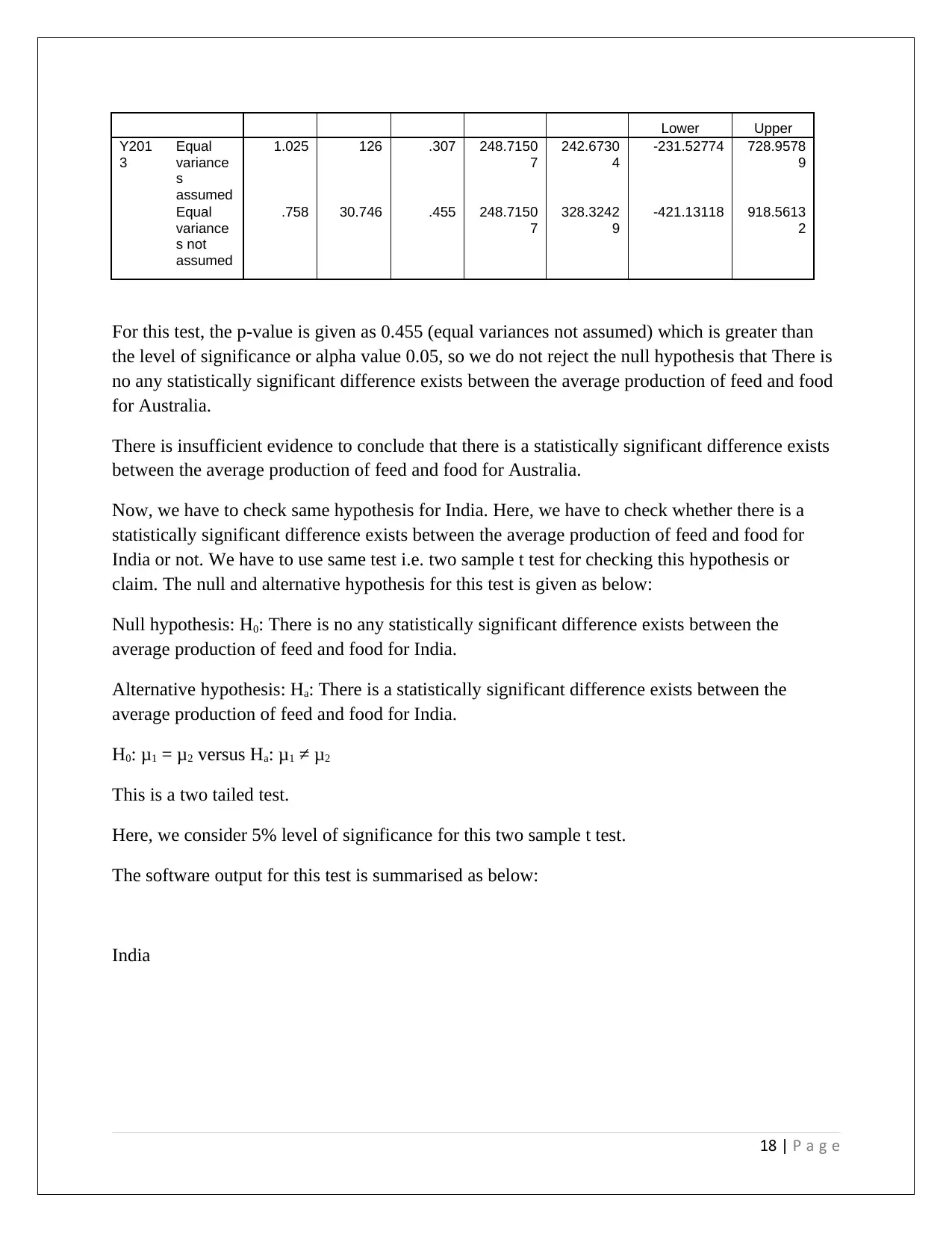
Lower Upper
Y201
3
Equal
variance
s
assumed
1.025 126 .307 248.7150
7
242.6730
4
-231.52774 728.9578
9
Equal
variance
s not
assumed
.758 30.746 .455 248.7150
7
328.3242
9
-421.13118 918.5613
2
For this test, the p-value is given as 0.455 (equal variances not assumed) which is greater than
the level of significance or alpha value 0.05, so we do not reject the null hypothesis that There is
no any statistically significant difference exists between the average production of feed and food
for Australia.
There is insufficient evidence to conclude that there is a statistically significant difference exists
between the average production of feed and food for Australia.
Now, we have to check same hypothesis for India. Here, we have to check whether there is a
statistically significant difference exists between the average production of feed and food for
India or not. We have to use same test i.e. two sample t test for checking this hypothesis or
claim. The null and alternative hypothesis for this test is given as below:
Null hypothesis: H0: There is no any statistically significant difference exists between the
average production of feed and food for India.
Alternative hypothesis: Ha: There is a statistically significant difference exists between the
average production of feed and food for India.
H0: μ1 = μ2 versus Ha: μ1 ≠ μ2
This is a two tailed test.
Here, we consider 5% level of significance for this two sample t test.
The software output for this test is summarised as below:
India
18 | P a g e
Y201
3
Equal
variance
s
assumed
1.025 126 .307 248.7150
7
242.6730
4
-231.52774 728.9578
9
Equal
variance
s not
assumed
.758 30.746 .455 248.7150
7
328.3242
9
-421.13118 918.5613
2
For this test, the p-value is given as 0.455 (equal variances not assumed) which is greater than
the level of significance or alpha value 0.05, so we do not reject the null hypothesis that There is
no any statistically significant difference exists between the average production of feed and food
for Australia.
There is insufficient evidence to conclude that there is a statistically significant difference exists
between the average production of feed and food for Australia.
Now, we have to check same hypothesis for India. Here, we have to check whether there is a
statistically significant difference exists between the average production of feed and food for
India or not. We have to use same test i.e. two sample t test for checking this hypothesis or
claim. The null and alternative hypothesis for this test is given as below:
Null hypothesis: H0: There is no any statistically significant difference exists between the
average production of feed and food for India.
Alternative hypothesis: Ha: There is a statistically significant difference exists between the
average production of feed and food for India.
H0: μ1 = μ2 versus Ha: μ1 ≠ μ2
This is a two tailed test.
Here, we consider 5% level of significance for this two sample t test.
The software output for this test is summarised as below:
India
18 | P a g e
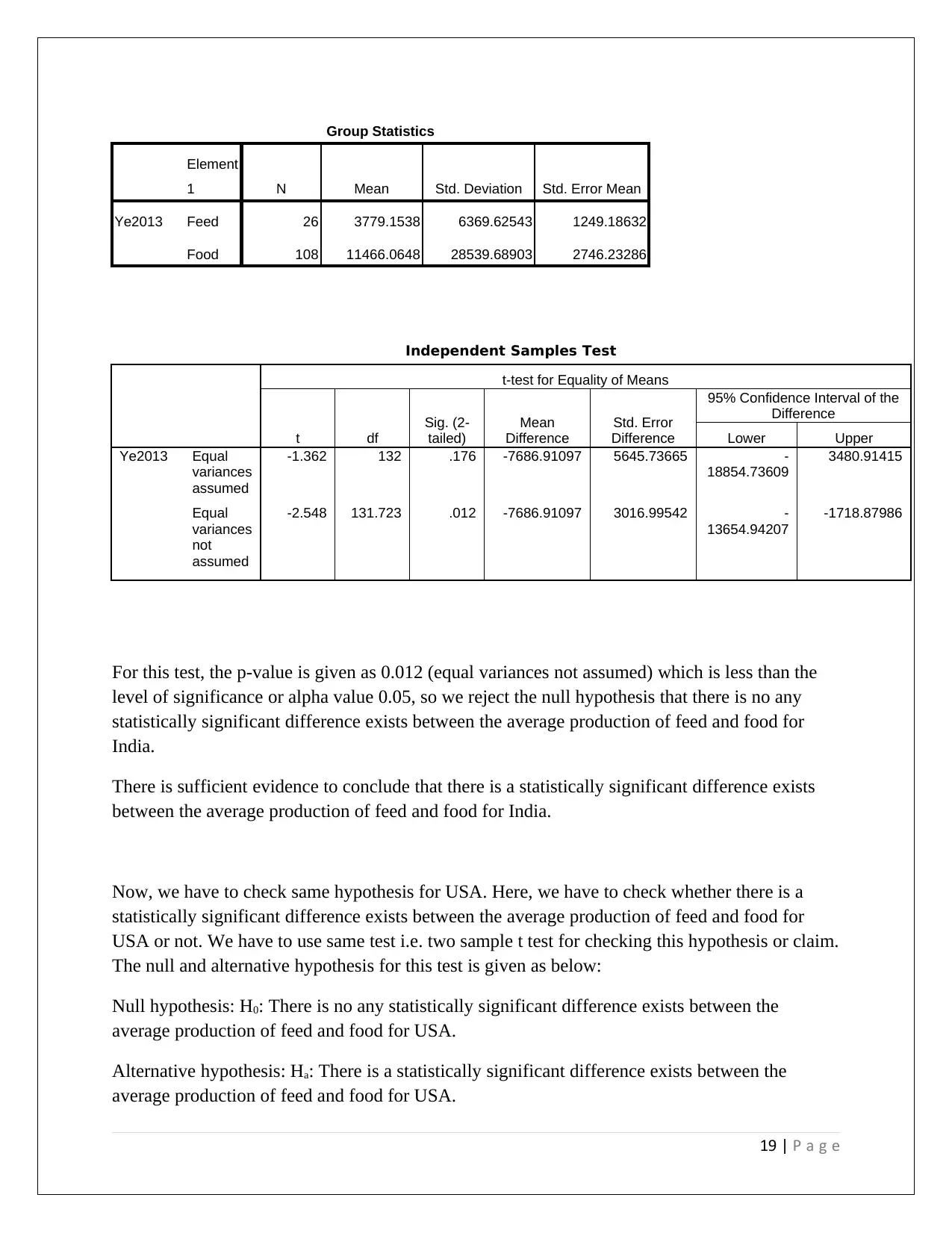
Group Statistics
Element
1 N Mean Std. Deviation Std. Error Mean
Ye2013 Feed 26 3779.1538 6369.62543 1249.18632
Food 108 11466.0648 28539.68903 2746.23286
Independent Samples Test
t-test for Equality of Means
t df
Sig. (2-
tailed)
Mean
Difference
Std. Error
Difference
95% Confidence Interval of the
Difference
Lower Upper
Ye2013 Equal
variances
assumed
-1.362 132 .176 -7686.91097 5645.73665 -
18854.73609
3480.91415
Equal
variances
not
assumed
-2.548 131.723 .012 -7686.91097 3016.99542 -
13654.94207
-1718.87986
For this test, the p-value is given as 0.012 (equal variances not assumed) which is less than the
level of significance or alpha value 0.05, so we reject the null hypothesis that there is no any
statistically significant difference exists between the average production of feed and food for
India.
There is sufficient evidence to conclude that there is a statistically significant difference exists
between the average production of feed and food for India.
Now, we have to check same hypothesis for USA. Here, we have to check whether there is a
statistically significant difference exists between the average production of feed and food for
USA or not. We have to use same test i.e. two sample t test for checking this hypothesis or claim.
The null and alternative hypothesis for this test is given as below:
Null hypothesis: H0: There is no any statistically significant difference exists between the
average production of feed and food for USA.
Alternative hypothesis: Ha: There is a statistically significant difference exists between the
average production of feed and food for USA.
19 | P a g e
Element
1 N Mean Std. Deviation Std. Error Mean
Ye2013 Feed 26 3779.1538 6369.62543 1249.18632
Food 108 11466.0648 28539.68903 2746.23286
Independent Samples Test
t-test for Equality of Means
t df
Sig. (2-
tailed)
Mean
Difference
Std. Error
Difference
95% Confidence Interval of the
Difference
Lower Upper
Ye2013 Equal
variances
assumed
-1.362 132 .176 -7686.91097 5645.73665 -
18854.73609
3480.91415
Equal
variances
not
assumed
-2.548 131.723 .012 -7686.91097 3016.99542 -
13654.94207
-1718.87986
For this test, the p-value is given as 0.012 (equal variances not assumed) which is less than the
level of significance or alpha value 0.05, so we reject the null hypothesis that there is no any
statistically significant difference exists between the average production of feed and food for
India.
There is sufficient evidence to conclude that there is a statistically significant difference exists
between the average production of feed and food for India.
Now, we have to check same hypothesis for USA. Here, we have to check whether there is a
statistically significant difference exists between the average production of feed and food for
USA or not. We have to use same test i.e. two sample t test for checking this hypothesis or claim.
The null and alternative hypothesis for this test is given as below:
Null hypothesis: H0: There is no any statistically significant difference exists between the
average production of feed and food for USA.
Alternative hypothesis: Ha: There is a statistically significant difference exists between the
average production of feed and food for USA.
19 | P a g e
Paraphrase This Document
Need a fresh take? Get an instant paraphrase of this document with our AI Paraphraser
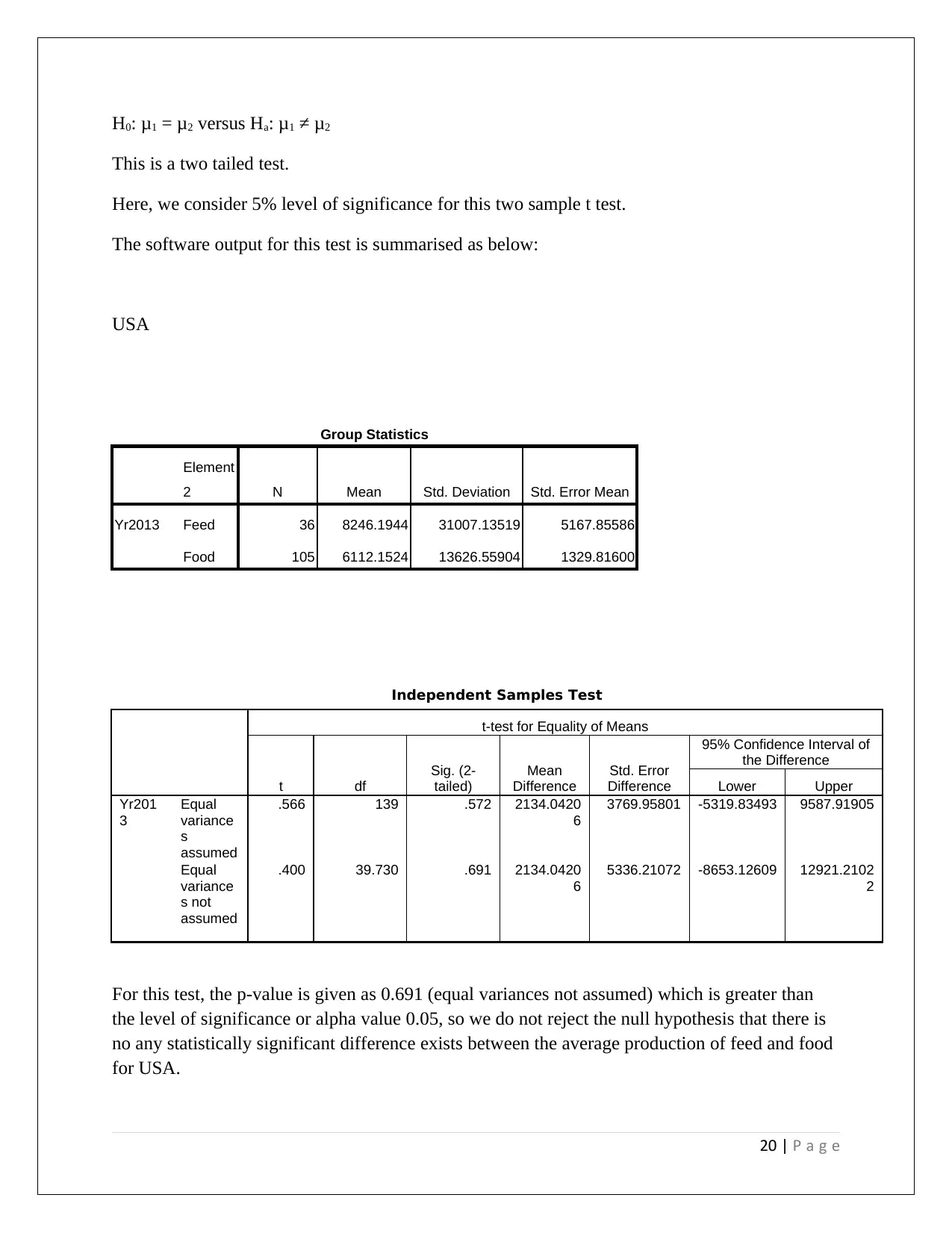
H0: μ1 = μ2 versus Ha: μ1 ≠ μ2
This is a two tailed test.
Here, we consider 5% level of significance for this two sample t test.
The software output for this test is summarised as below:
USA
Group Statistics
Element
2 N Mean Std. Deviation Std. Error Mean
Yr2013 Feed 36 8246.1944 31007.13519 5167.85586
Food 105 6112.1524 13626.55904 1329.81600
Independent Samples Test
t-test for Equality of Means
t df
Sig. (2-
tailed)
Mean
Difference
Std. Error
Difference
95% Confidence Interval of
the Difference
Lower Upper
Yr201
3
Equal
variance
s
assumed
.566 139 .572 2134.0420
6
3769.95801 -5319.83493 9587.91905
Equal
variance
s not
assumed
.400 39.730 .691 2134.0420
6
5336.21072 -8653.12609 12921.2102
2
For this test, the p-value is given as 0.691 (equal variances not assumed) which is greater than
the level of significance or alpha value 0.05, so we do not reject the null hypothesis that there is
no any statistically significant difference exists between the average production of feed and food
for USA.
20 | P a g e
This is a two tailed test.
Here, we consider 5% level of significance for this two sample t test.
The software output for this test is summarised as below:
USA
Group Statistics
Element
2 N Mean Std. Deviation Std. Error Mean
Yr2013 Feed 36 8246.1944 31007.13519 5167.85586
Food 105 6112.1524 13626.55904 1329.81600
Independent Samples Test
t-test for Equality of Means
t df
Sig. (2-
tailed)
Mean
Difference
Std. Error
Difference
95% Confidence Interval of
the Difference
Lower Upper
Yr201
3
Equal
variance
s
assumed
.566 139 .572 2134.0420
6
3769.95801 -5319.83493 9587.91905
Equal
variance
s not
assumed
.400 39.730 .691 2134.0420
6
5336.21072 -8653.12609 12921.2102
2
For this test, the p-value is given as 0.691 (equal variances not assumed) which is greater than
the level of significance or alpha value 0.05, so we do not reject the null hypothesis that there is
no any statistically significant difference exists between the average production of feed and food
for USA.
20 | P a g e
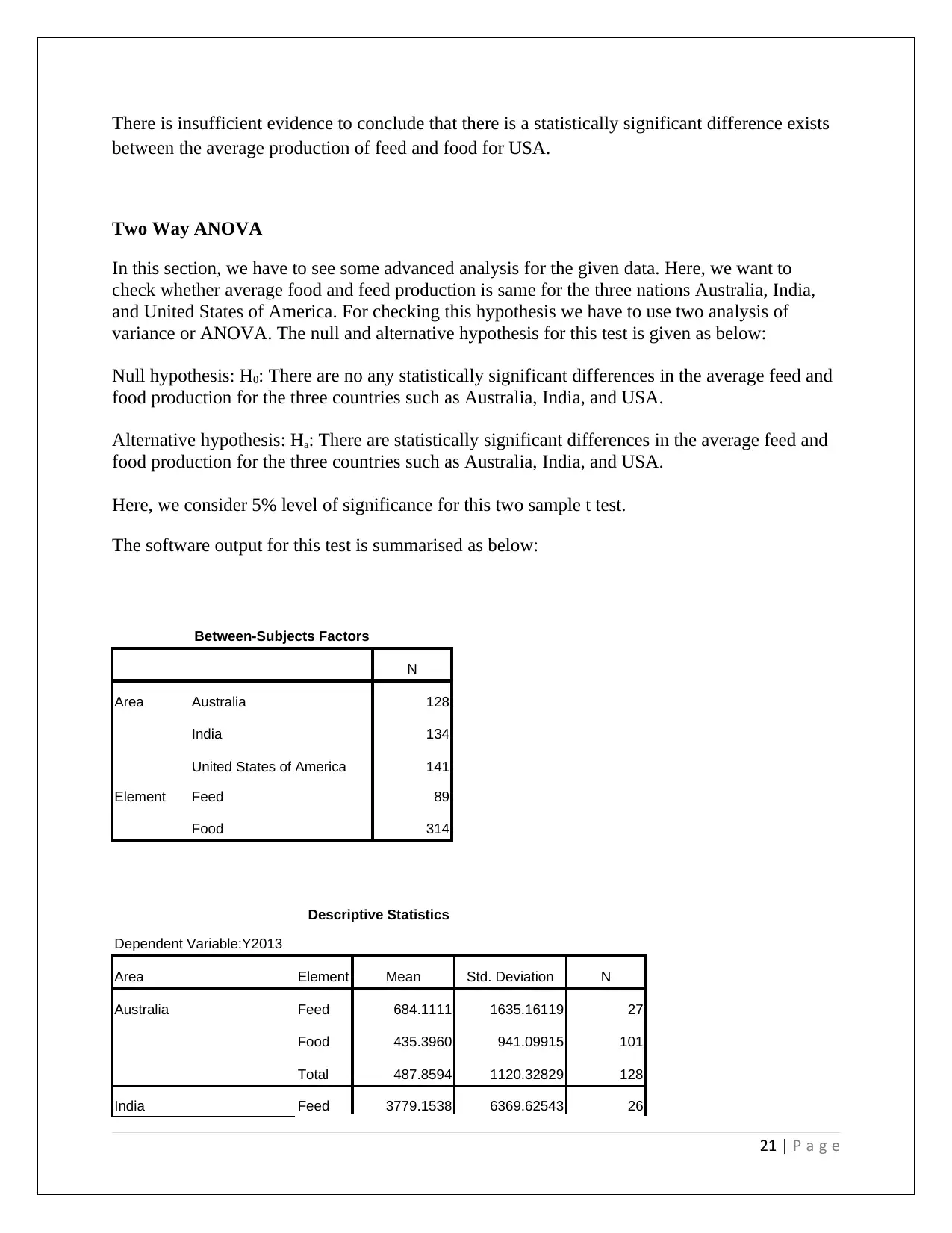
There is insufficient evidence to conclude that there is a statistically significant difference exists
between the average production of feed and food for USA.
Two Way ANOVA
In this section, we have to see some advanced analysis for the given data. Here, we want to
check whether average food and feed production is same for the three nations Australia, India,
and United States of America. For checking this hypothesis we have to use two analysis of
variance or ANOVA. The null and alternative hypothesis for this test is given as below:
Null hypothesis: H0: There are no any statistically significant differences in the average feed and
food production for the three countries such as Australia, India, and USA.
Alternative hypothesis: Ha: There are statistically significant differences in the average feed and
food production for the three countries such as Australia, India, and USA.
Here, we consider 5% level of significance for this two sample t test.
The software output for this test is summarised as below:
Between-Subjects Factors
N
Area Australia 128
India 134
United States of America 141
Element Feed 89
Food 314
Descriptive Statistics
Dependent Variable:Y2013
Area Element Mean Std. Deviation N
Australia Feed 684.1111 1635.16119 27
Food 435.3960 941.09915 101
Total 487.8594 1120.32829 128
India Feed 3779.1538 6369.62543 26
21 | P a g e
between the average production of feed and food for USA.
Two Way ANOVA
In this section, we have to see some advanced analysis for the given data. Here, we want to
check whether average food and feed production is same for the three nations Australia, India,
and United States of America. For checking this hypothesis we have to use two analysis of
variance or ANOVA. The null and alternative hypothesis for this test is given as below:
Null hypothesis: H0: There are no any statistically significant differences in the average feed and
food production for the three countries such as Australia, India, and USA.
Alternative hypothesis: Ha: There are statistically significant differences in the average feed and
food production for the three countries such as Australia, India, and USA.
Here, we consider 5% level of significance for this two sample t test.
The software output for this test is summarised as below:
Between-Subjects Factors
N
Area Australia 128
India 134
United States of America 141
Element Feed 89
Food 314
Descriptive Statistics
Dependent Variable:Y2013
Area Element Mean Std. Deviation N
Australia Feed 684.1111 1635.16119 27
Food 435.3960 941.09915 101
Total 487.8594 1120.32829 128
India Feed 3779.1538 6369.62543 26
21 | P a g e
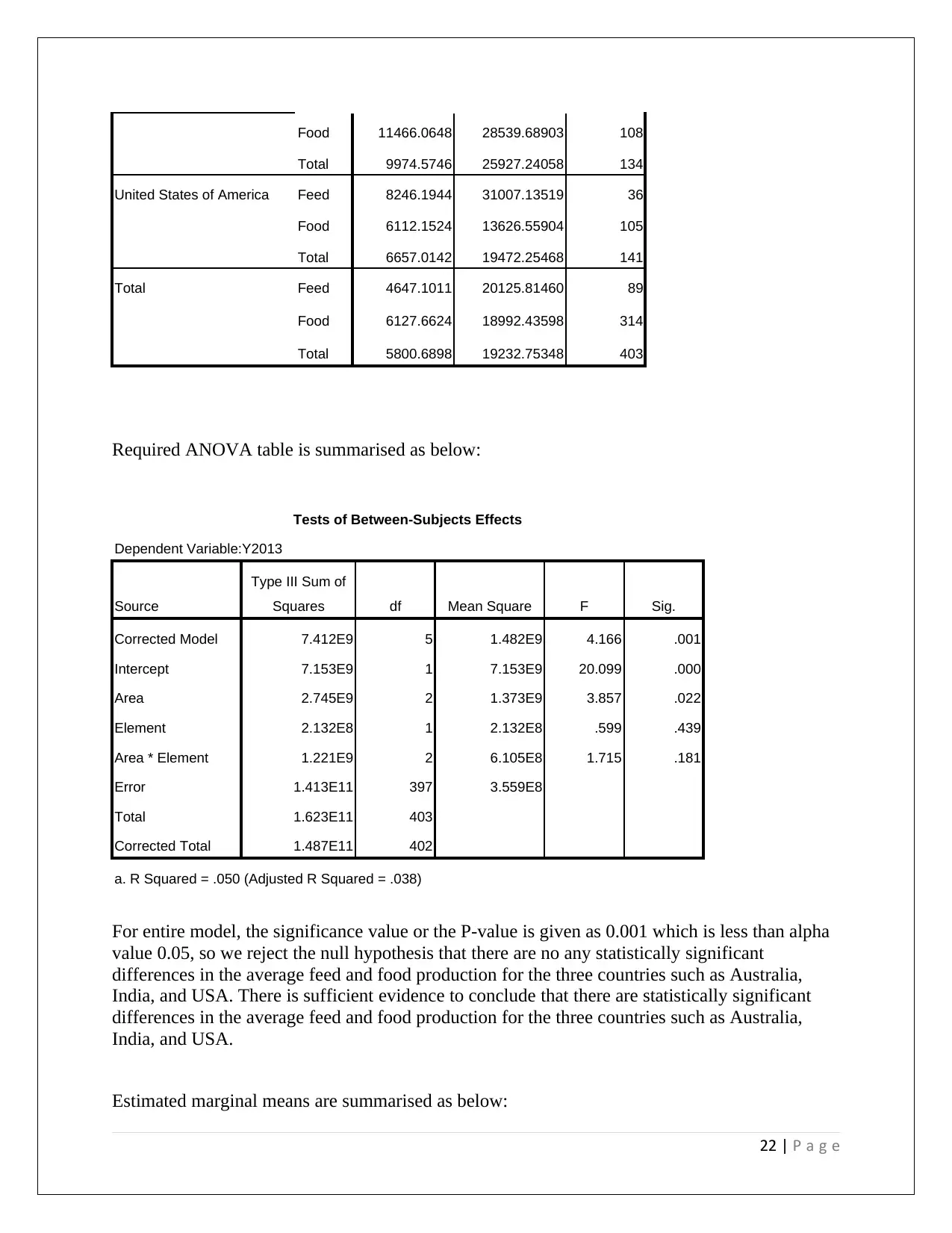
Food 11466.0648 28539.68903 108
Total 9974.5746 25927.24058 134
United States of America Feed 8246.1944 31007.13519 36
Food 6112.1524 13626.55904 105
Total 6657.0142 19472.25468 141
Total Feed 4647.1011 20125.81460 89
Food 6127.6624 18992.43598 314
Total 5800.6898 19232.75348 403
Required ANOVA table is summarised as below:
Tests of Between-Subjects Effects
Dependent Variable:Y2013
Source
Type III Sum of
Squares df Mean Square F Sig.
Corrected Model 7.412E9 5 1.482E9 4.166 .001
Intercept 7.153E9 1 7.153E9 20.099 .000
Area 2.745E9 2 1.373E9 3.857 .022
Element 2.132E8 1 2.132E8 .599 .439
Area * Element 1.221E9 2 6.105E8 1.715 .181
Error 1.413E11 397 3.559E8
Total 1.623E11 403
Corrected Total 1.487E11 402
a. R Squared = .050 (Adjusted R Squared = .038)
For entire model, the significance value or the P-value is given as 0.001 which is less than alpha
value 0.05, so we reject the null hypothesis that there are no any statistically significant
differences in the average feed and food production for the three countries such as Australia,
India, and USA. There is sufficient evidence to conclude that there are statistically significant
differences in the average feed and food production for the three countries such as Australia,
India, and USA.
Estimated marginal means are summarised as below:
22 | P a g e
Total 9974.5746 25927.24058 134
United States of America Feed 8246.1944 31007.13519 36
Food 6112.1524 13626.55904 105
Total 6657.0142 19472.25468 141
Total Feed 4647.1011 20125.81460 89
Food 6127.6624 18992.43598 314
Total 5800.6898 19232.75348 403
Required ANOVA table is summarised as below:
Tests of Between-Subjects Effects
Dependent Variable:Y2013
Source
Type III Sum of
Squares df Mean Square F Sig.
Corrected Model 7.412E9 5 1.482E9 4.166 .001
Intercept 7.153E9 1 7.153E9 20.099 .000
Area 2.745E9 2 1.373E9 3.857 .022
Element 2.132E8 1 2.132E8 .599 .439
Area * Element 1.221E9 2 6.105E8 1.715 .181
Error 1.413E11 397 3.559E8
Total 1.623E11 403
Corrected Total 1.487E11 402
a. R Squared = .050 (Adjusted R Squared = .038)
For entire model, the significance value or the P-value is given as 0.001 which is less than alpha
value 0.05, so we reject the null hypothesis that there are no any statistically significant
differences in the average feed and food production for the three countries such as Australia,
India, and USA. There is sufficient evidence to conclude that there are statistically significant
differences in the average feed and food production for the three countries such as Australia,
India, and USA.
Estimated marginal means are summarised as below:
22 | P a g e
Secure Best Marks with AI Grader
Need help grading? Try our AI Grader for instant feedback on your assignments.
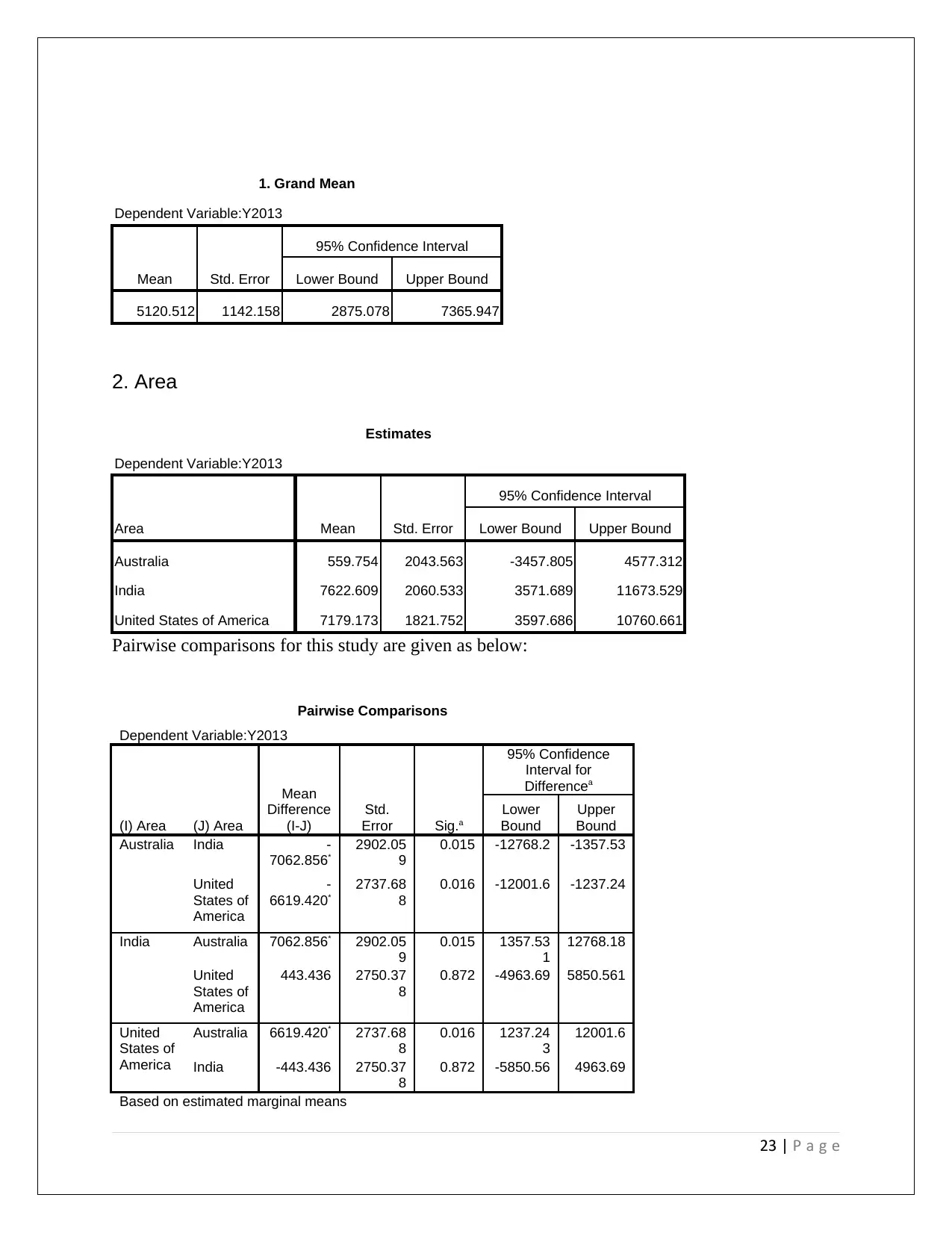
1. Grand Mean
Dependent Variable:Y2013
Mean Std. Error
95% Confidence Interval
Lower Bound Upper Bound
5120.512 1142.158 2875.078 7365.947
2. Area
Estimates
Dependent Variable:Y2013
Area Mean Std. Error
95% Confidence Interval
Lower Bound Upper Bound
Australia 559.754 2043.563 -3457.805 4577.312
India 7622.609 2060.533 3571.689 11673.529
United States of America 7179.173 1821.752 3597.686 10760.661
Pairwise comparisons for this study are given as below:
Pairwise Comparisons
Dependent Variable:Y2013
(I) Area (J) Area
Mean
Difference
(I-J)
Std.
Error Sig.a
95% Confidence
Interval for
Differencea
Lower
Bound
Upper
Bound
Australia India -
7062.856*
2902.05
9
0.015 -12768.2 -1357.53
United
States of
America
-
6619.420*
2737.68
8
0.016 -12001.6 -1237.24
India Australia 7062.856* 2902.05
9
0.015 1357.53
1
12768.18
United
States of
America
443.436 2750.37
8
0.872 -4963.69 5850.561
United
States of
America
Australia 6619.420* 2737.68
8
0.016 1237.24
3
12001.6
India -443.436 2750.37
8
0.872 -5850.56 4963.69
Based on estimated marginal means
23 | P a g e
Dependent Variable:Y2013
Mean Std. Error
95% Confidence Interval
Lower Bound Upper Bound
5120.512 1142.158 2875.078 7365.947
2. Area
Estimates
Dependent Variable:Y2013
Area Mean Std. Error
95% Confidence Interval
Lower Bound Upper Bound
Australia 559.754 2043.563 -3457.805 4577.312
India 7622.609 2060.533 3571.689 11673.529
United States of America 7179.173 1821.752 3597.686 10760.661
Pairwise comparisons for this study are given as below:
Pairwise Comparisons
Dependent Variable:Y2013
(I) Area (J) Area
Mean
Difference
(I-J)
Std.
Error Sig.a
95% Confidence
Interval for
Differencea
Lower
Bound
Upper
Bound
Australia India -
7062.856*
2902.05
9
0.015 -12768.2 -1357.53
United
States of
America
-
6619.420*
2737.68
8
0.016 -12001.6 -1237.24
India Australia 7062.856* 2902.05
9
0.015 1357.53
1
12768.18
United
States of
America
443.436 2750.37
8
0.872 -4963.69 5850.561
United
States of
America
Australia 6619.420* 2737.68
8
0.016 1237.24
3
12001.6
India -443.436 2750.37
8
0.872 -5850.56 4963.69
Based on estimated marginal means
23 | P a g e
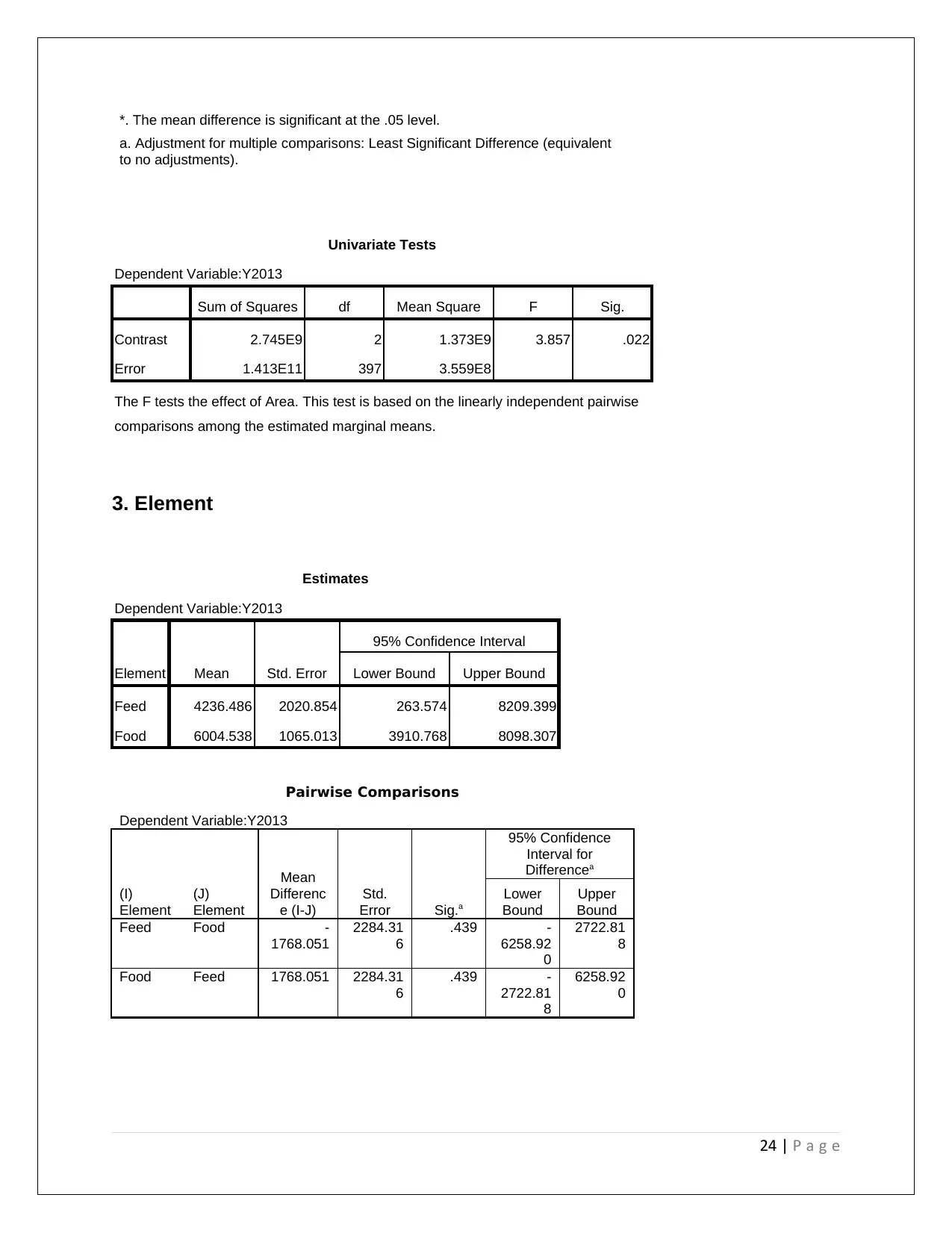
*. The mean difference is significant at the .05 level.
a. Adjustment for multiple comparisons: Least Significant Difference (equivalent
to no adjustments).
Univariate Tests
Dependent Variable:Y2013
Sum of Squares df Mean Square F Sig.
Contrast 2.745E9 2 1.373E9 3.857 .022
Error 1.413E11 397 3.559E8
The F tests the effect of Area. This test is based on the linearly independent pairwise
comparisons among the estimated marginal means.
3. Element
Estimates
Dependent Variable:Y2013
Element Mean Std. Error
95% Confidence Interval
Lower Bound Upper Bound
Feed 4236.486 2020.854 263.574 8209.399
Food 6004.538 1065.013 3910.768 8098.307
Pairwise Comparisons
Dependent Variable:Y2013
(I)
Element
(J)
Element
Mean
Differenc
e (I-J)
Std.
Error Sig.a
95% Confidence
Interval for
Differencea
Lower
Bound
Upper
Bound
Feed Food -
1768.051
2284.31
6
.439 -
6258.92
0
2722.81
8
Food Feed 1768.051 2284.31
6
.439 -
2722.81
8
6258.92
0
24 | P a g e
a. Adjustment for multiple comparisons: Least Significant Difference (equivalent
to no adjustments).
Univariate Tests
Dependent Variable:Y2013
Sum of Squares df Mean Square F Sig.
Contrast 2.745E9 2 1.373E9 3.857 .022
Error 1.413E11 397 3.559E8
The F tests the effect of Area. This test is based on the linearly independent pairwise
comparisons among the estimated marginal means.
3. Element
Estimates
Dependent Variable:Y2013
Element Mean Std. Error
95% Confidence Interval
Lower Bound Upper Bound
Feed 4236.486 2020.854 263.574 8209.399
Food 6004.538 1065.013 3910.768 8098.307
Pairwise Comparisons
Dependent Variable:Y2013
(I)
Element
(J)
Element
Mean
Differenc
e (I-J)
Std.
Error Sig.a
95% Confidence
Interval for
Differencea
Lower
Bound
Upper
Bound
Feed Food -
1768.051
2284.31
6
.439 -
6258.92
0
2722.81
8
Food Feed 1768.051 2284.31
6
.439 -
2722.81
8
6258.92
0
24 | P a g e
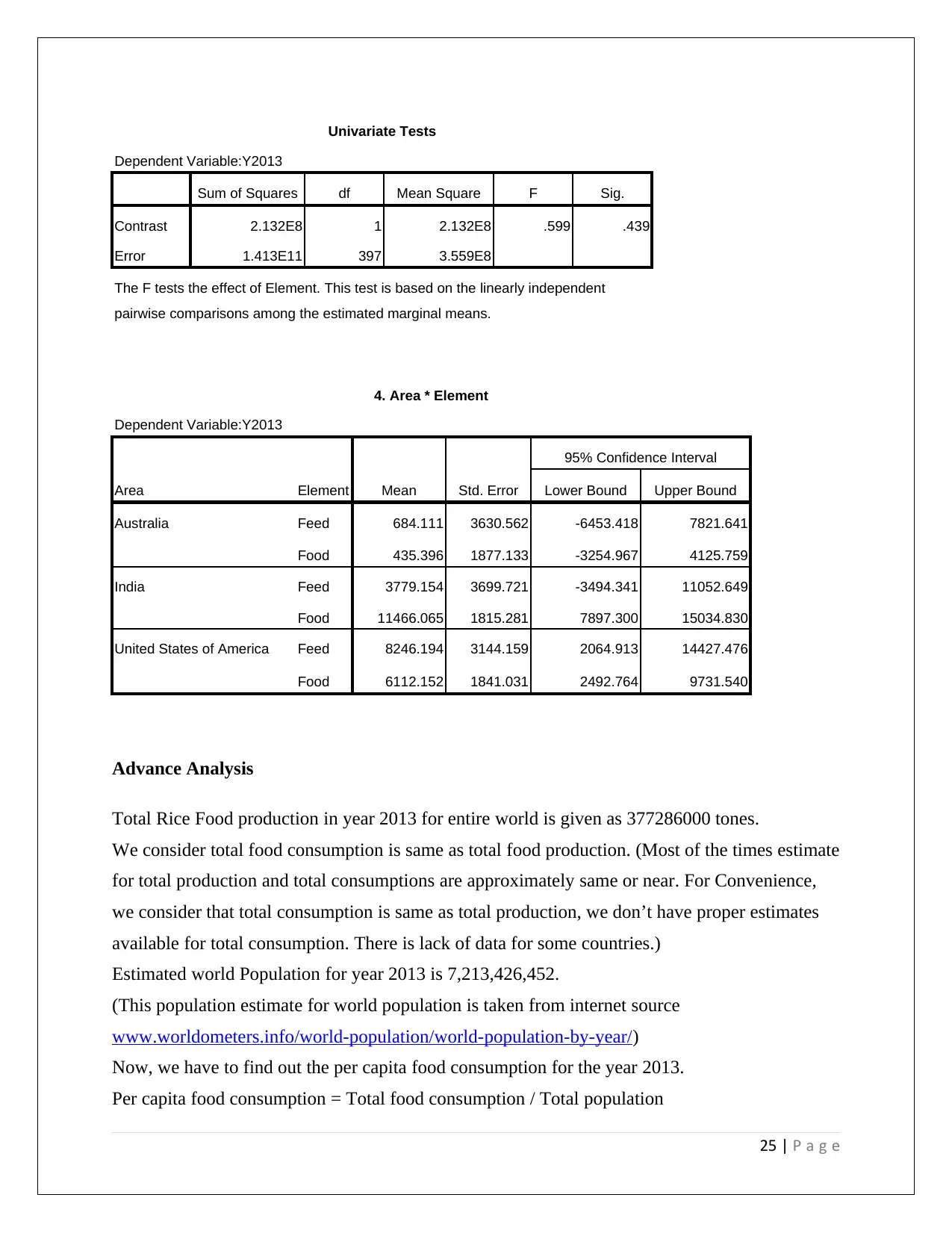
Univariate Tests
Dependent Variable:Y2013
Sum of Squares df Mean Square F Sig.
Contrast 2.132E8 1 2.132E8 .599 .439
Error 1.413E11 397 3.559E8
The F tests the effect of Element. This test is based on the linearly independent
pairwise comparisons among the estimated marginal means.
4. Area * Element
Dependent Variable:Y2013
Area Element Mean Std. Error
95% Confidence Interval
Lower Bound Upper Bound
Australia Feed 684.111 3630.562 -6453.418 7821.641
Food 435.396 1877.133 -3254.967 4125.759
India Feed 3779.154 3699.721 -3494.341 11052.649
Food 11466.065 1815.281 7897.300 15034.830
United States of America Feed 8246.194 3144.159 2064.913 14427.476
Food 6112.152 1841.031 2492.764 9731.540
Advance Analysis
Total Rice Food production in year 2013 for entire world is given as 377286000 tones.
We consider total food consumption is same as total food production. (Most of the times estimate
for total production and total consumptions are approximately same or near. For Convenience,
we consider that total consumption is same as total production, we don’t have proper estimates
available for total consumption. There is lack of data for some countries.)
Estimated world Population for year 2013 is 7,213,426,452.
(This population estimate for world population is taken from internet source
www.worldometers.info/world-population/world-population-by-year/)
Now, we have to find out the per capita food consumption for the year 2013.
Per capita food consumption = Total food consumption / Total population
25 | P a g e
Dependent Variable:Y2013
Sum of Squares df Mean Square F Sig.
Contrast 2.132E8 1 2.132E8 .599 .439
Error 1.413E11 397 3.559E8
The F tests the effect of Element. This test is based on the linearly independent
pairwise comparisons among the estimated marginal means.
4. Area * Element
Dependent Variable:Y2013
Area Element Mean Std. Error
95% Confidence Interval
Lower Bound Upper Bound
Australia Feed 684.111 3630.562 -6453.418 7821.641
Food 435.396 1877.133 -3254.967 4125.759
India Feed 3779.154 3699.721 -3494.341 11052.649
Food 11466.065 1815.281 7897.300 15034.830
United States of America Feed 8246.194 3144.159 2064.913 14427.476
Food 6112.152 1841.031 2492.764 9731.540
Advance Analysis
Total Rice Food production in year 2013 for entire world is given as 377286000 tones.
We consider total food consumption is same as total food production. (Most of the times estimate
for total production and total consumptions are approximately same or near. For Convenience,
we consider that total consumption is same as total production, we don’t have proper estimates
available for total consumption. There is lack of data for some countries.)
Estimated world Population for year 2013 is 7,213,426,452.
(This population estimate for world population is taken from internet source
www.worldometers.info/world-population/world-population-by-year/)
Now, we have to find out the per capita food consumption for the year 2013.
Per capita food consumption = Total food consumption / Total population
25 | P a g e
Paraphrase This Document
Need a fresh take? Get an instant paraphrase of this document with our AI Paraphraser
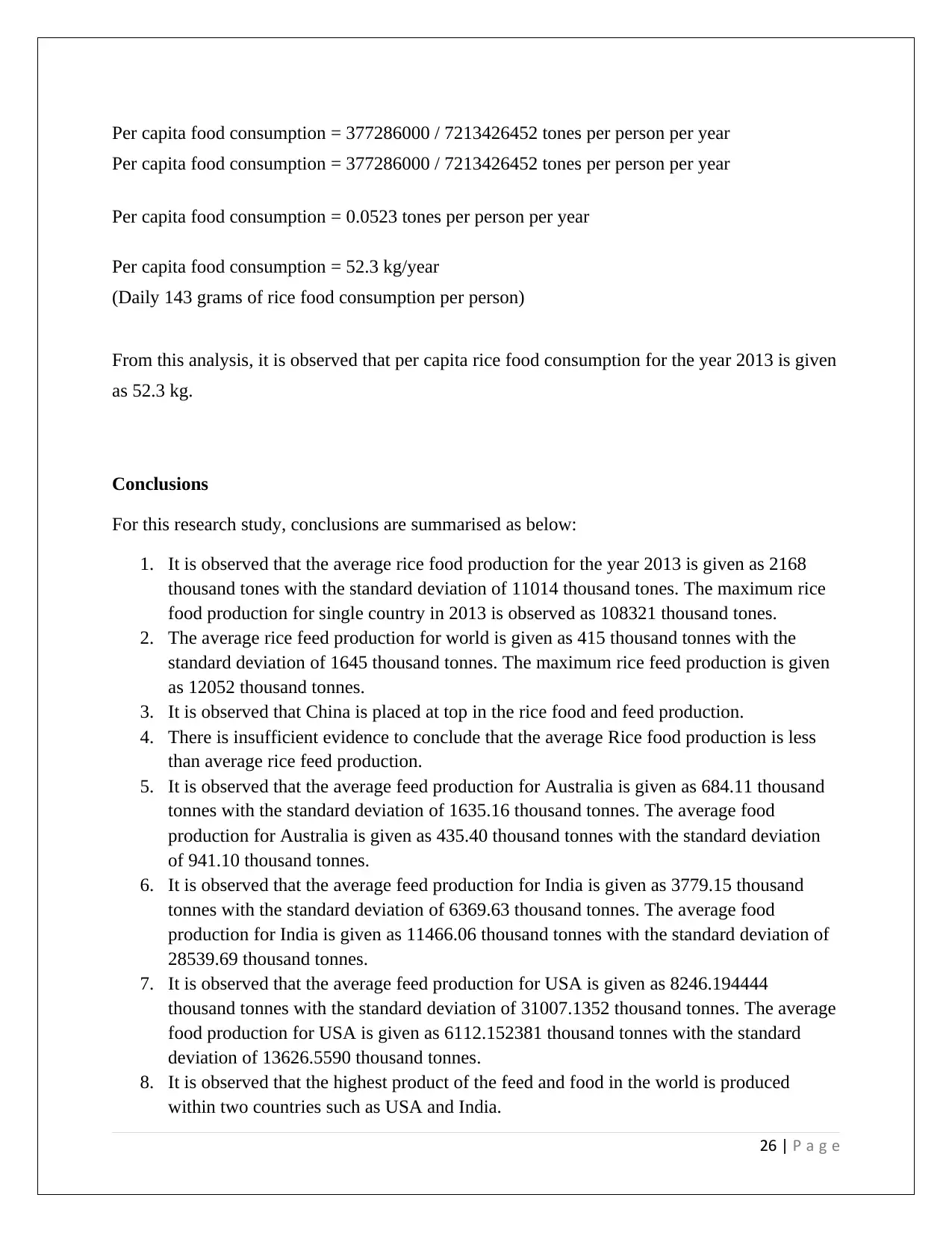
Per capita food consumption = 377286000 / 7213426452 tones per person per year
Per capita food consumption = 377286000 / 7213426452 tones per person per year
Per capita food consumption = 0.0523 tones per person per year
Per capita food consumption = 52.3 kg/year
(Daily 143 grams of rice food consumption per person)
From this analysis, it is observed that per capita rice food consumption for the year 2013 is given
as 52.3 kg.
Conclusions
For this research study, conclusions are summarised as below:
1. It is observed that the average rice food production for the year 2013 is given as 2168
thousand tones with the standard deviation of 11014 thousand tones. The maximum rice
food production for single country in 2013 is observed as 108321 thousand tones.
2. The average rice feed production for world is given as 415 thousand tonnes with the
standard deviation of 1645 thousand tonnes. The maximum rice feed production is given
as 12052 thousand tonnes.
3. It is observed that China is placed at top in the rice food and feed production.
4. There is insufficient evidence to conclude that the average Rice food production is less
than average rice feed production.
5. It is observed that the average feed production for Australia is given as 684.11 thousand
tonnes with the standard deviation of 1635.16 thousand tonnes. The average food
production for Australia is given as 435.40 thousand tonnes with the standard deviation
of 941.10 thousand tonnes.
6. It is observed that the average feed production for India is given as 3779.15 thousand
tonnes with the standard deviation of 6369.63 thousand tonnes. The average food
production for India is given as 11466.06 thousand tonnes with the standard deviation of
28539.69 thousand tonnes.
7. It is observed that the average feed production for USA is given as 8246.194444
thousand tonnes with the standard deviation of 31007.1352 thousand tonnes. The average
food production for USA is given as 6112.152381 thousand tonnes with the standard
deviation of 13626.5590 thousand tonnes.
8. It is observed that the highest product of the feed and food in the world is produced
within two countries such as USA and India.
26 | P a g e
Per capita food consumption = 377286000 / 7213426452 tones per person per year
Per capita food consumption = 0.0523 tones per person per year
Per capita food consumption = 52.3 kg/year
(Daily 143 grams of rice food consumption per person)
From this analysis, it is observed that per capita rice food consumption for the year 2013 is given
as 52.3 kg.
Conclusions
For this research study, conclusions are summarised as below:
1. It is observed that the average rice food production for the year 2013 is given as 2168
thousand tones with the standard deviation of 11014 thousand tones. The maximum rice
food production for single country in 2013 is observed as 108321 thousand tones.
2. The average rice feed production for world is given as 415 thousand tonnes with the
standard deviation of 1645 thousand tonnes. The maximum rice feed production is given
as 12052 thousand tonnes.
3. It is observed that China is placed at top in the rice food and feed production.
4. There is insufficient evidence to conclude that the average Rice food production is less
than average rice feed production.
5. It is observed that the average feed production for Australia is given as 684.11 thousand
tonnes with the standard deviation of 1635.16 thousand tonnes. The average food
production for Australia is given as 435.40 thousand tonnes with the standard deviation
of 941.10 thousand tonnes.
6. It is observed that the average feed production for India is given as 3779.15 thousand
tonnes with the standard deviation of 6369.63 thousand tonnes. The average food
production for India is given as 11466.06 thousand tonnes with the standard deviation of
28539.69 thousand tonnes.
7. It is observed that the average feed production for USA is given as 8246.194444
thousand tonnes with the standard deviation of 31007.1352 thousand tonnes. The average
food production for USA is given as 6112.152381 thousand tonnes with the standard
deviation of 13626.5590 thousand tonnes.
8. It is observed that the highest product of the feed and food in the world is produced
within two countries such as USA and India.
26 | P a g e
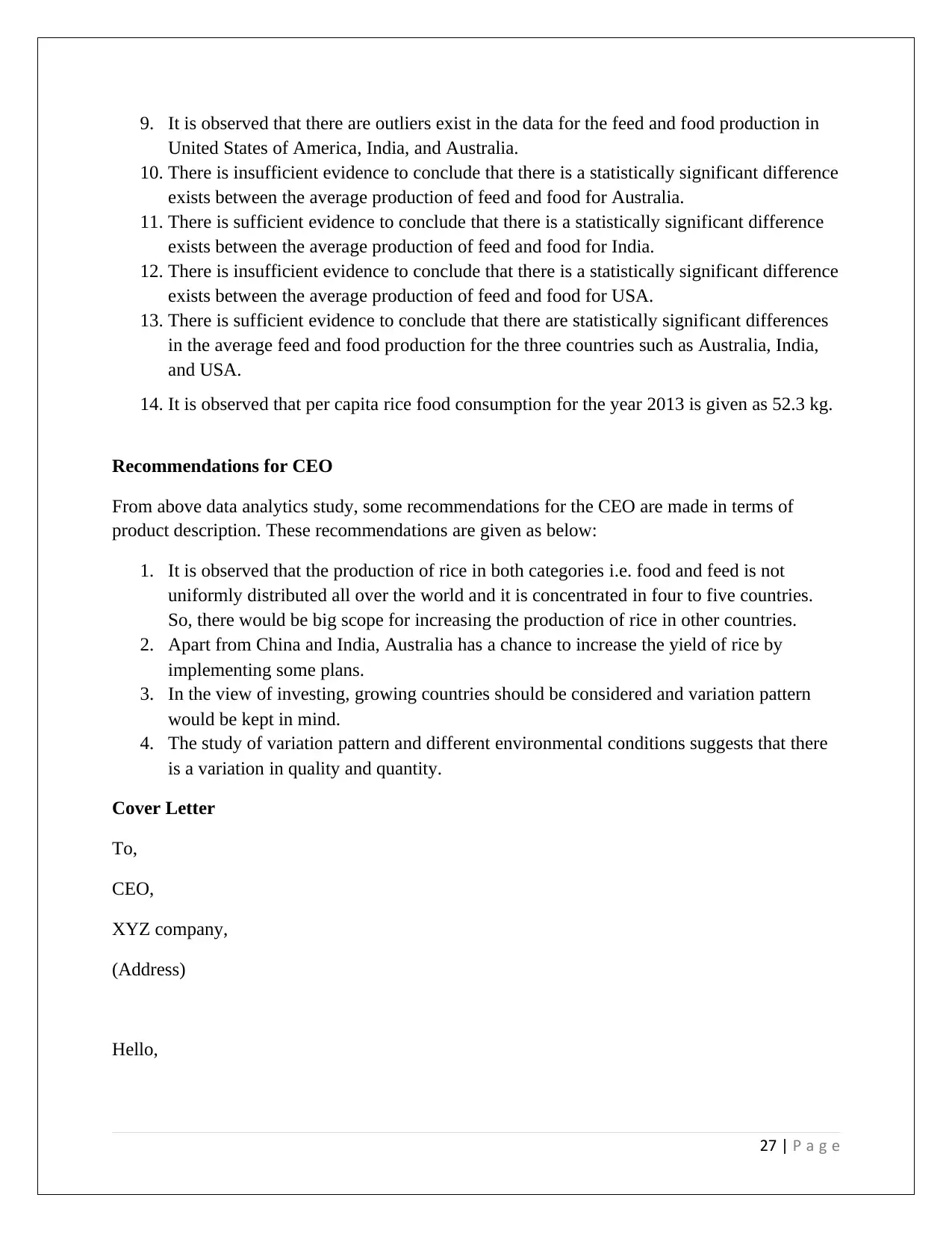
9. It is observed that there are outliers exist in the data for the feed and food production in
United States of America, India, and Australia.
10. There is insufficient evidence to conclude that there is a statistically significant difference
exists between the average production of feed and food for Australia.
11. There is sufficient evidence to conclude that there is a statistically significant difference
exists between the average production of feed and food for India.
12. There is insufficient evidence to conclude that there is a statistically significant difference
exists between the average production of feed and food for USA.
13. There is sufficient evidence to conclude that there are statistically significant differences
in the average feed and food production for the three countries such as Australia, India,
and USA.
14. It is observed that per capita rice food consumption for the year 2013 is given as 52.3 kg.
Recommendations for CEO
From above data analytics study, some recommendations for the CEO are made in terms of
product description. These recommendations are given as below:
1. It is observed that the production of rice in both categories i.e. food and feed is not
uniformly distributed all over the world and it is concentrated in four to five countries.
So, there would be big scope for increasing the production of rice in other countries.
2. Apart from China and India, Australia has a chance to increase the yield of rice by
implementing some plans.
3. In the view of investing, growing countries should be considered and variation pattern
would be kept in mind.
4. The study of variation pattern and different environmental conditions suggests that there
is a variation in quality and quantity.
Cover Letter
To,
CEO,
XYZ company,
(Address)
Hello,
27 | P a g e
United States of America, India, and Australia.
10. There is insufficient evidence to conclude that there is a statistically significant difference
exists between the average production of feed and food for Australia.
11. There is sufficient evidence to conclude that there is a statistically significant difference
exists between the average production of feed and food for India.
12. There is insufficient evidence to conclude that there is a statistically significant difference
exists between the average production of feed and food for USA.
13. There is sufficient evidence to conclude that there are statistically significant differences
in the average feed and food production for the three countries such as Australia, India,
and USA.
14. It is observed that per capita rice food consumption for the year 2013 is given as 52.3 kg.
Recommendations for CEO
From above data analytics study, some recommendations for the CEO are made in terms of
product description. These recommendations are given as below:
1. It is observed that the production of rice in both categories i.e. food and feed is not
uniformly distributed all over the world and it is concentrated in four to five countries.
So, there would be big scope for increasing the production of rice in other countries.
2. Apart from China and India, Australia has a chance to increase the yield of rice by
implementing some plans.
3. In the view of investing, growing countries should be considered and variation pattern
would be kept in mind.
4. The study of variation pattern and different environmental conditions suggests that there
is a variation in quality and quantity.
Cover Letter
To,
CEO,
XYZ company,
(Address)
Hello,
27 | P a g e
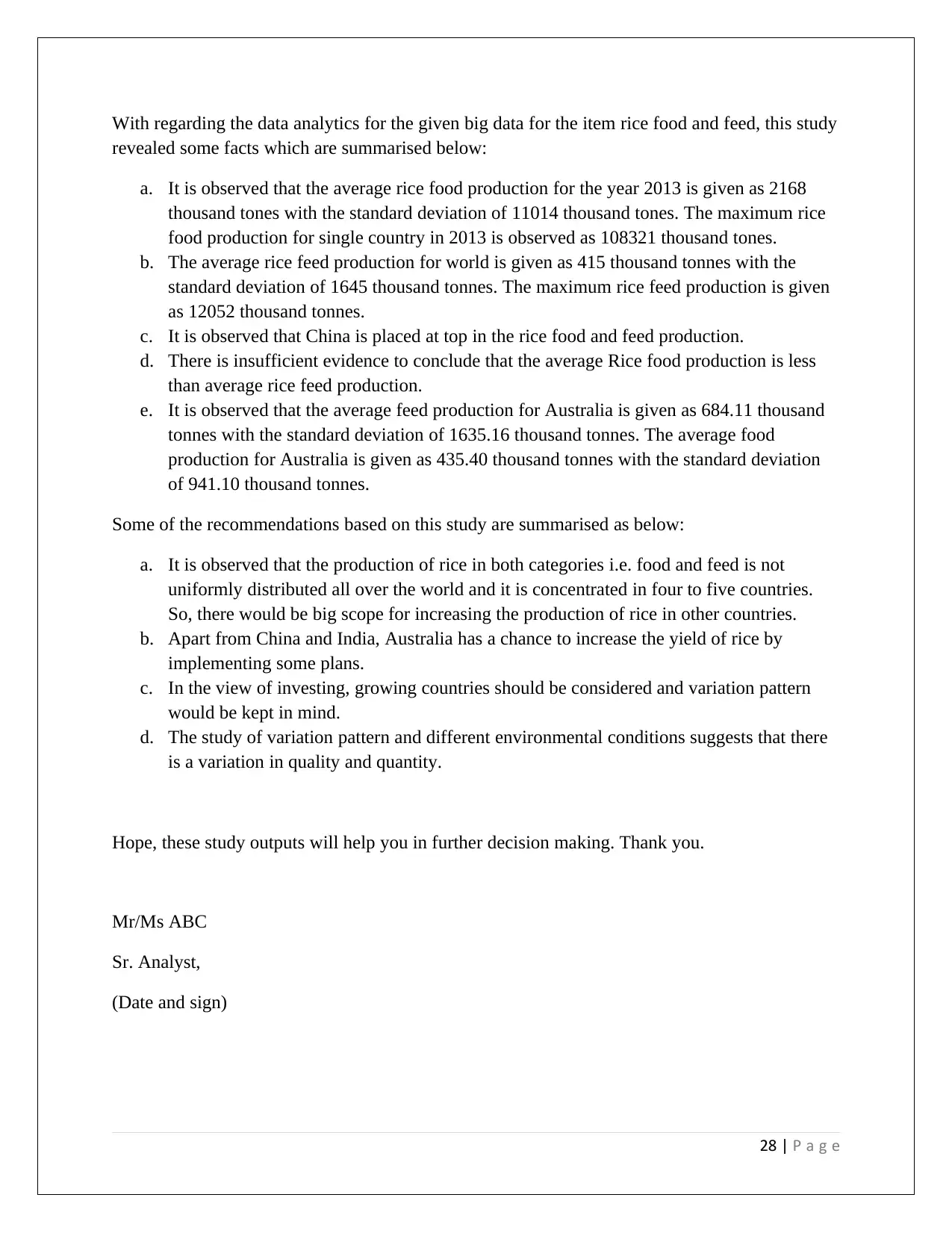
With regarding the data analytics for the given big data for the item rice food and feed, this study
revealed some facts which are summarised below:
a. It is observed that the average rice food production for the year 2013 is given as 2168
thousand tones with the standard deviation of 11014 thousand tones. The maximum rice
food production for single country in 2013 is observed as 108321 thousand tones.
b. The average rice feed production for world is given as 415 thousand tonnes with the
standard deviation of 1645 thousand tonnes. The maximum rice feed production is given
as 12052 thousand tonnes.
c. It is observed that China is placed at top in the rice food and feed production.
d. There is insufficient evidence to conclude that the average Rice food production is less
than average rice feed production.
e. It is observed that the average feed production for Australia is given as 684.11 thousand
tonnes with the standard deviation of 1635.16 thousand tonnes. The average food
production for Australia is given as 435.40 thousand tonnes with the standard deviation
of 941.10 thousand tonnes.
Some of the recommendations based on this study are summarised as below:
a. It is observed that the production of rice in both categories i.e. food and feed is not
uniformly distributed all over the world and it is concentrated in four to five countries.
So, there would be big scope for increasing the production of rice in other countries.
b. Apart from China and India, Australia has a chance to increase the yield of rice by
implementing some plans.
c. In the view of investing, growing countries should be considered and variation pattern
would be kept in mind.
d. The study of variation pattern and different environmental conditions suggests that there
is a variation in quality and quantity.
Hope, these study outputs will help you in further decision making. Thank you.
Mr/Ms ABC
Sr. Analyst,
(Date and sign)
28 | P a g e
revealed some facts which are summarised below:
a. It is observed that the average rice food production for the year 2013 is given as 2168
thousand tones with the standard deviation of 11014 thousand tones. The maximum rice
food production for single country in 2013 is observed as 108321 thousand tones.
b. The average rice feed production for world is given as 415 thousand tonnes with the
standard deviation of 1645 thousand tonnes. The maximum rice feed production is given
as 12052 thousand tonnes.
c. It is observed that China is placed at top in the rice food and feed production.
d. There is insufficient evidence to conclude that the average Rice food production is less
than average rice feed production.
e. It is observed that the average feed production for Australia is given as 684.11 thousand
tonnes with the standard deviation of 1635.16 thousand tonnes. The average food
production for Australia is given as 435.40 thousand tonnes with the standard deviation
of 941.10 thousand tonnes.
Some of the recommendations based on this study are summarised as below:
a. It is observed that the production of rice in both categories i.e. food and feed is not
uniformly distributed all over the world and it is concentrated in four to five countries.
So, there would be big scope for increasing the production of rice in other countries.
b. Apart from China and India, Australia has a chance to increase the yield of rice by
implementing some plans.
c. In the view of investing, growing countries should be considered and variation pattern
would be kept in mind.
d. The study of variation pattern and different environmental conditions suggests that there
is a variation in quality and quantity.
Hope, these study outputs will help you in further decision making. Thank you.
Mr/Ms ABC
Sr. Analyst,
(Date and sign)
28 | P a g e
Secure Best Marks with AI Grader
Need help grading? Try our AI Grader for instant feedback on your assignments.
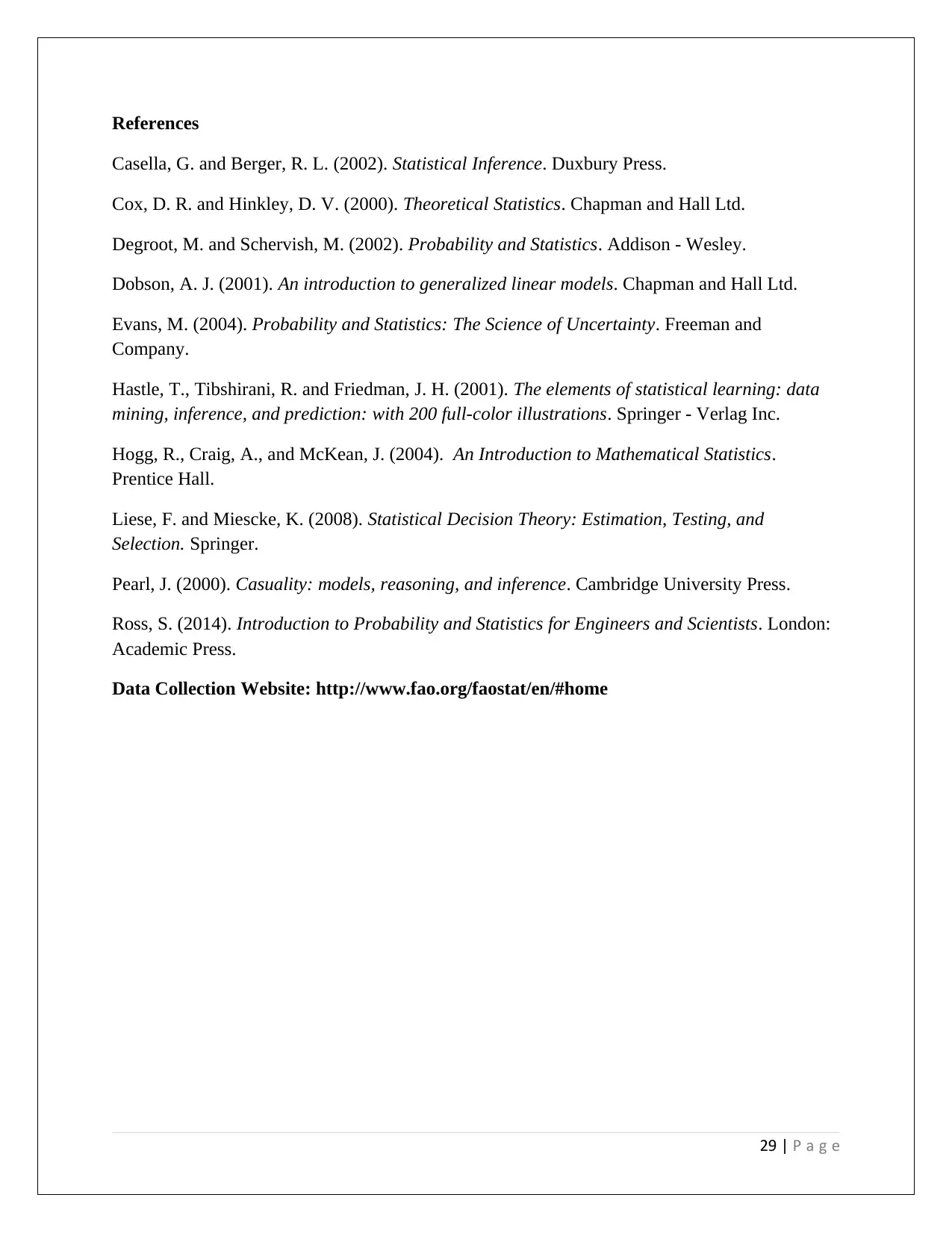
References
Casella, G. and Berger, R. L. (2002). Statistical Inference. Duxbury Press.
Cox, D. R. and Hinkley, D. V. (2000). Theoretical Statistics. Chapman and Hall Ltd.
Degroot, M. and Schervish, M. (2002). Probability and Statistics. Addison - Wesley.
Dobson, A. J. (2001). An introduction to generalized linear models. Chapman and Hall Ltd.
Evans, M. (2004). Probability and Statistics: The Science of Uncertainty. Freeman and
Company.
Hastle, T., Tibshirani, R. and Friedman, J. H. (2001). The elements of statistical learning: data
mining, inference, and prediction: with 200 full-color illustrations. Springer - Verlag Inc.
Hogg, R., Craig, A., and McKean, J. (2004). An Introduction to Mathematical Statistics.
Prentice Hall.
Liese, F. and Miescke, K. (2008). Statistical Decision Theory: Estimation, Testing, and
Selection. Springer.
Pearl, J. (2000). Casuality: models, reasoning, and inference. Cambridge University Press.
Ross, S. (2014). Introduction to Probability and Statistics for Engineers and Scientists. London:
Academic Press.
Data Collection Website: http://www.fao.org/faostat/en/#home
29 | P a g e
Casella, G. and Berger, R. L. (2002). Statistical Inference. Duxbury Press.
Cox, D. R. and Hinkley, D. V. (2000). Theoretical Statistics. Chapman and Hall Ltd.
Degroot, M. and Schervish, M. (2002). Probability and Statistics. Addison - Wesley.
Dobson, A. J. (2001). An introduction to generalized linear models. Chapman and Hall Ltd.
Evans, M. (2004). Probability and Statistics: The Science of Uncertainty. Freeman and
Company.
Hastle, T., Tibshirani, R. and Friedman, J. H. (2001). The elements of statistical learning: data
mining, inference, and prediction: with 200 full-color illustrations. Springer - Verlag Inc.
Hogg, R., Craig, A., and McKean, J. (2004). An Introduction to Mathematical Statistics.
Prentice Hall.
Liese, F. and Miescke, K. (2008). Statistical Decision Theory: Estimation, Testing, and
Selection. Springer.
Pearl, J. (2000). Casuality: models, reasoning, and inference. Cambridge University Press.
Ross, S. (2014). Introduction to Probability and Statistics for Engineers and Scientists. London:
Academic Press.
Data Collection Website: http://www.fao.org/faostat/en/#home
29 | P a g e
1 out of 29
Related Documents
Your All-in-One AI-Powered Toolkit for Academic Success.
+13062052269
info@desklib.com
Available 24*7 on WhatsApp / Email
![[object Object]](/_next/static/media/star-bottom.7253800d.svg)
Unlock your academic potential
© 2024 | Zucol Services PVT LTD | All rights reserved.




